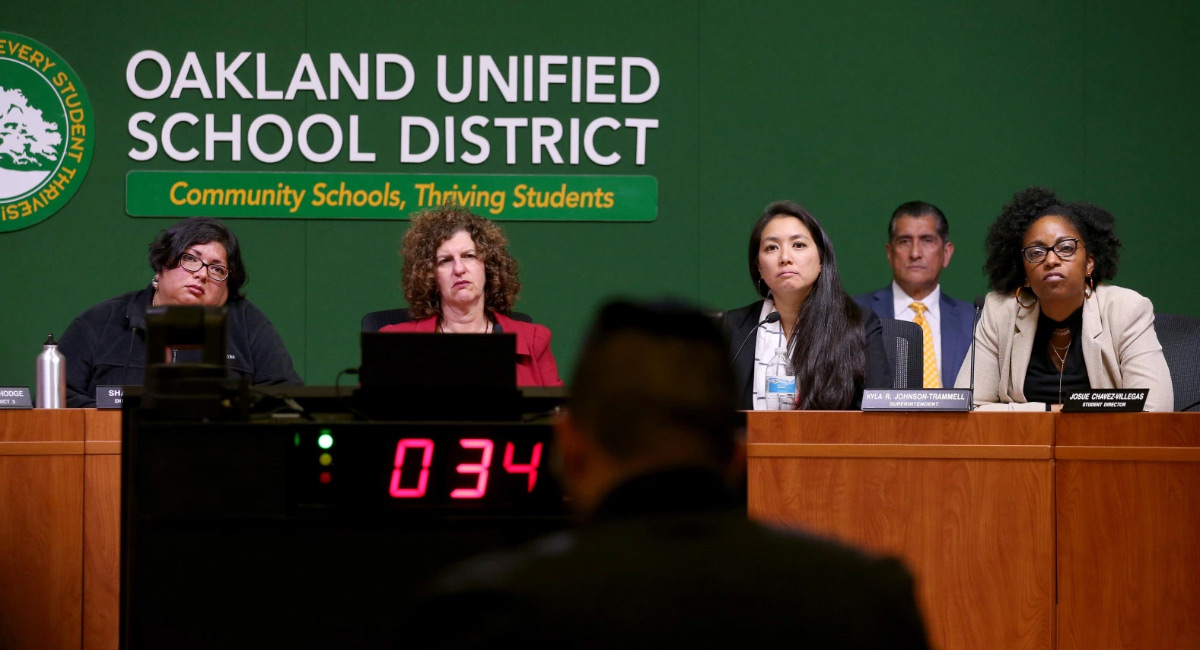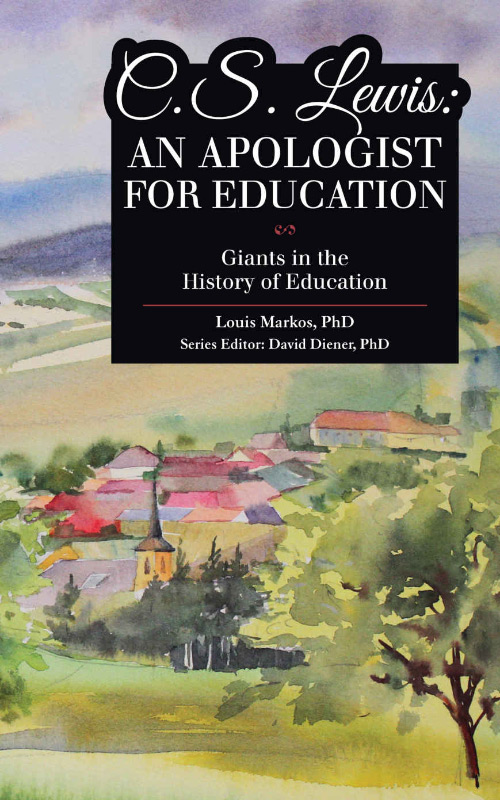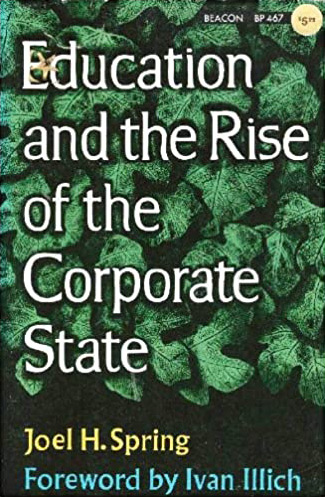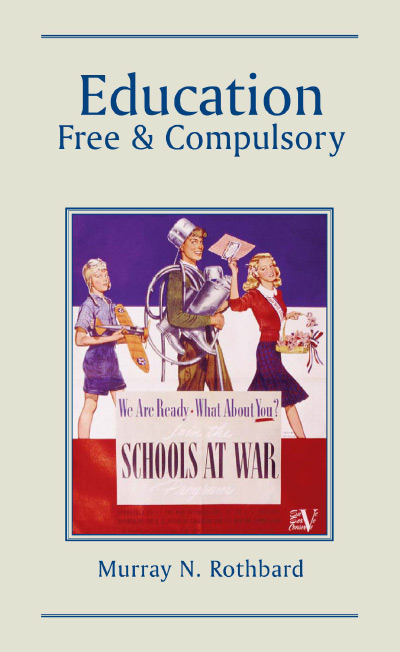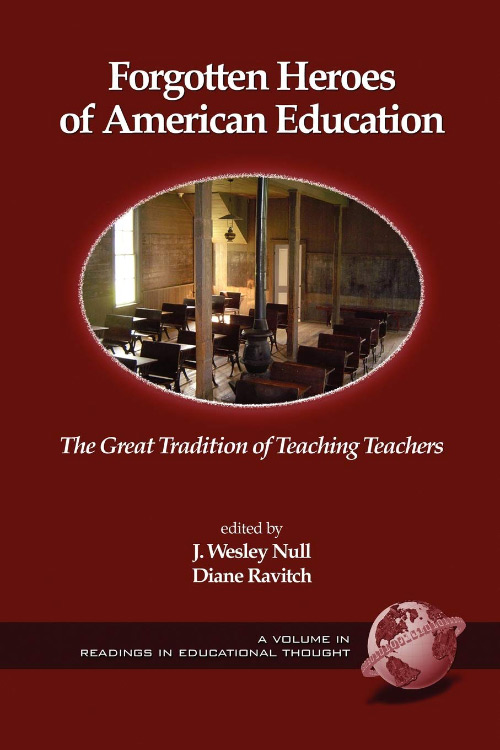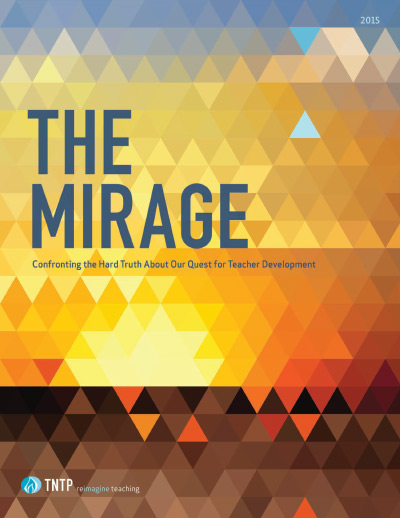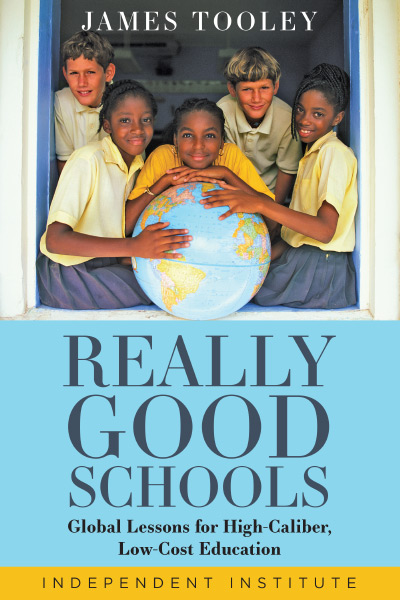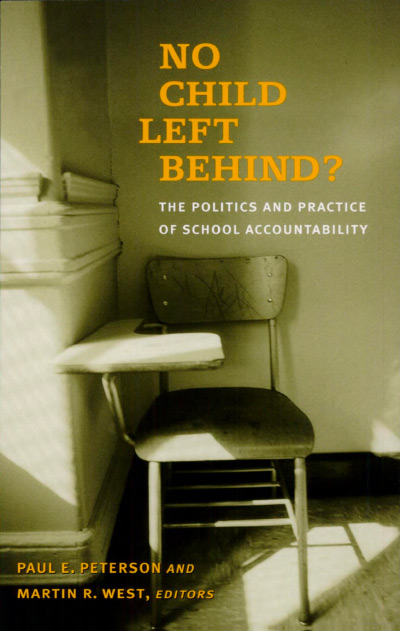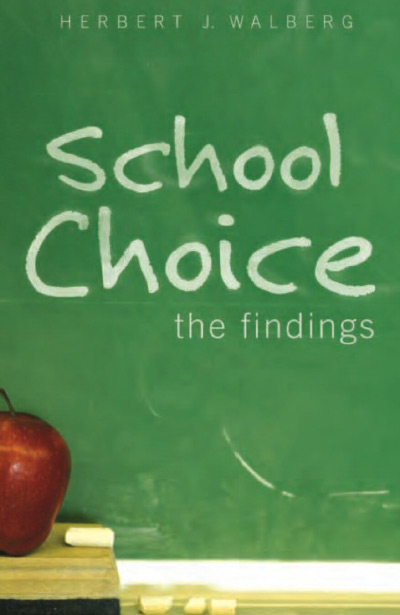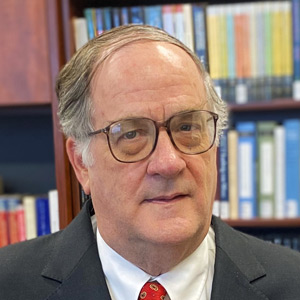Part one of three of the series Recommended Readings on Education.
Part Two: K-12 Education: Subject Matter, Curriculum, and Teaching Methods
Part Three: American Higher Education’s Maladies and Remedies
We spend so much effort on our own (or our children’s) education, yet too little time educating ourselves about education, its history, and its varieties. This neglect can impair K-12 education reform by limiting the options under discussion and preventing us from addressing the most important question of all: How might we overhaul the school system—including the underlying government framework of education—so that schools better serve students’ and families’ diverse needs and preferences?
The following annotated bibliography can help close the knowledge gap—and encourage the transformation necessary to give children the education they deserve. Crucially, it offers foundational perspectives (sometimes from decades or even centuries ago) as well as recommendations precipitated by more immediate concerns. Readers conversant with this literature will be far better prepared to contribute to public dialogue on K-12 education than those familiar only with the latest school board report, task-force recommendations, or education policy op-ed.
This bibliography is a part of a K-12 Series together with the Subject Matter and Teaching Methods bibliography. This list, a project of the Independent Institute’s Center on Educational Excellence, will undergo periodic updating and refinement. Please send us your suggestions for future iterations, and share the list with others to encourage their feedback.
Nostrums debunked include: Abolishing tracking, class size reduction, community schools, money per se is what matters, national curriculum-content standards, restorative justice, school district consolidation, school turnarounds, single salary schedule for teacher pay, teacher certification, and teacher’s bonuses for having a master’s degree.
If you can read just one item on this list, then make it Education Myths, by Jay P. Greene. If you can read only two, make your second choice Special Interest, by Terry M. Moe.
“Adam Smith on Schooling: A Classical Liberal Rereading,” by Scott Drylie. Journal of Economic Behavior and Organization.
From the abstract: “[Adam Smith's article “Of the Expense of the Institutions for the Education of Youth” in The Wealth of Nations] considers several policy measures, but it is wrong to conclude that he favors government subsidization. Attention to his complex rhetoric reveals that he deprecates Montesquieu's reasoning for government provision, and he censures warm sentiments when they urge the same conclusion. Besides treating the issue of policy, this article addresses the claim that Smith favored compulsory schooling.”
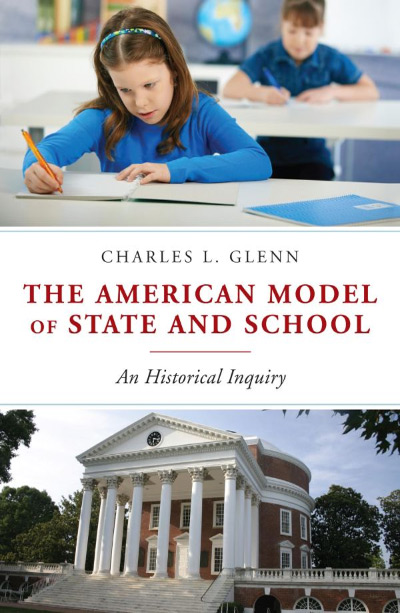 The American Model of State and School: An Historical Inquiry, by Charles L. Glenn. Continuum, 2012.
The American Model of State and School: An Historical Inquiry, by Charles L. Glenn. Continuum, 2012.
A history of ideas about American public elementary education from the nineteen century into the twentieth century. Kevin Currie-Wright writes, “[T]he moral of Glenn's story is largely that the more centralized schooling became, the more religious and cultural diversity began to become a real problem for schools. When schools were decentralized and local affairs—often allowing parents to go to private schools with government subsidy when necessary—localities if not families could choose whether they wanted schools with religious instruction (the answer was almost always ‘yes!’), what religion would be taught, and how. Once you centralize and increase the number of folks who have to receive instruction one way (the state-desired way), you run into problems like that of 1850's New York City, where Catholics unsuccessfully waged a battle to get state funding for Catholic (rather than blatantly Protestant) schools ... or 1920's Oregon, where the anti-Catholic majority passed a bill outlawing private schooling completely.
“Another moral of Glenn's book is that the trend of centralization of educational decisions was more or less accompanied by a belief among educators (and educationists) that decisions should be made by experts rather than parents and community members. When Horace Mann and others created state-run “normal schools” (teacher-training institutes), they created institutions that, over decades, turned out teachers whose views on what schools should do became increasingly at odds with the views of parents and local community members. The penultimate chapter—an analysis of the work of John Dewey and his effect on the world of education—shows that while Dewey frequently talked of the importance of democracy, he really never meant democracy-as-a-system-of-political-decision-making, but democracy-as-a-set-of-Deweyan-ideals (which often clashed markedly with what parents wanted to see from schools).... Glenn's conclusion is that schools should be “disestablished” and we should return to a decentralized system of schooling, preferably one allowing for parental choice....”
About progressive educational theorist John Dewey, Glenn writes, “It was Dewey who provided a theoretical rationale for understanding education as the primary means of creating an improved humanity, not through the promotion of skills and knowledge but through a process of quasi-religious conversion.... The implication is that we are not to be concerned with determining the truth about an historical occurrence or process, but only what we can use from the past as a storehouse of examples.... Dewey sought to create a new kind of society through the stimulation, in schoolchildren, of cooperative habits and goals.... While seemingly spontaneous, much of what went into a progressive classroom was, in fact, determined well ahead of time. A major difference between the progressive classroom and a conventional classroom was, therefore, that in the former the guidance was hidden.... Similarly in the future society that Dewey sought to achieve through this pedagogical approach [Arthur Zilversmit writes], ‘constraints would not be eliminated but they would be replaced by a hidden form of social control.’”
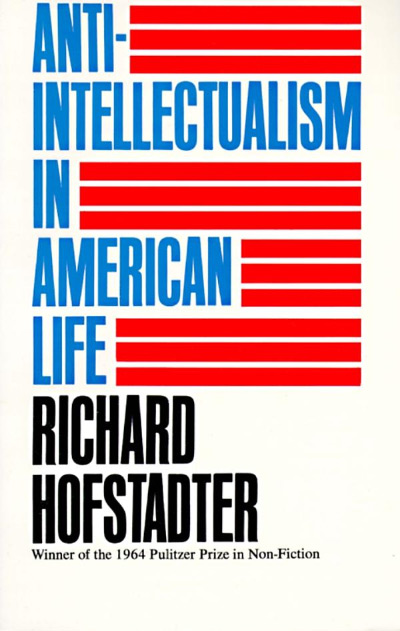 Anti-Intellectualism in American Life, by Richard Hofstader. Vintage, 1963.
Anti-Intellectualism in American Life, by Richard Hofstader. Vintage, 1963.
Hofstadter covers a considerable number of topics in this book. We are concerned in particular with chapter 13: “The Road to Life Adjustment.” Hofstadter writes, “It is impossible here to stress too much the impetus given to the new educational creed [Life Adjustment] by the moral atmosphere of Progressivism. ... There is an element of moral overstrain and a curious lack of humor among American educationists which will perhaps always remain a mystery to those more worldly minds that are locked out of their mental universe. The more humdrum the task the educationists have to undertake, the nobler and more exalted their music grows. When they see a chance to introduce a new course in family living or home economics, they begin to tune the fiddles of their idealism. ... The silly season in educational writing had now opened.
“[Sixty percent of American youth were deemed unfit for college or skilled occupations] and should be given education for life adjustment: ... ‘ethical and moral living’; home and family life; citizenship; the uses of leisure; how to take care of their health; ‘occupational adjustment.’ Here, as the authors of Life Adjustment Education for Every Youth put it, was ‘a philosophy of education which places life values above acquisition of knowledge.’ The conception, implicit in this observation, that knowledge has little or nothing to do with ‘life values,’ was an essential premise of the whole movement. Repeatedly, life adjustment educators were to insist that intellectual training is of no use in solving the ‘real life problems’ of ordinary youth. ...
“For all this, early and late, [John] Dewey’s thought was constantly invoked. ... What many of Dewey’s followers have done, with or without complete license from the master himself, is to attack the ideas of leadership and guidance, and the values of culture and reflective life, in favor of certain notions of spontaneity, democracy, and practicality. ...
“It will be apparent that the new education was presented to the world not simply as an instrumentality but as a creed, which went beyond the hope of this or that strictly educational result to promise some kind of ultimate salvation for individuals or for the race. ... [F]or example, ... G. Stanley Hall foresaw that an education designed in accordance with the nature of child growth would rear the superman of the future. Dewey’s early view of the possibilities of education were likewise exalted. Education, he said in his well-titled little pamphlet, My Pedagogic Creed, ‘is the fundamental method of social progress and reform.’ Hence the teacher must be seen as ‘engaged, not simply in the training of individuals, but in the formation of the proper social life.’ Every teacher should accordingly think of himself as ‘a social servant set apart for the maintenance of proper social order and the securing of the right social growth. In this way the teacher always is the prophet of the true God and the usherer of the true kingdom of God.’”
“Attention OECD-PISA: Your Silence on China Is Wrong,” by Tom Loveless. Brown Center Chalkboard Series Report, Dec. 11, 2013.
The Programme for International Student Assessment (PISA) covers up the plight of children of internal migrants in Communist China and the vastly inferior public schools they are forced to attend. Loveless writes, “Not a word on a discriminatory policy affecting the education of millions of Chinese [migrant] children. Not a word on the human rights story of migrant families in China and the human suffering that they must endure.”
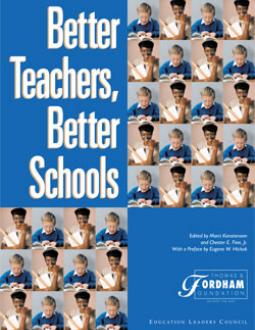 Better Teachers, Better Schools, ed. by Marci Kanstoroom and Chester E. Finn Jr. Thomas B. Fordham Foundation, 1999. Download PDF
Better Teachers, Better Schools, ed. by Marci Kanstoroom and Chester E. Finn Jr. Thomas B. Fordham Foundation, 1999. Download PDF
This collection presents proposals for improving teacher quality. As ERIC summarizes it: “These approaches involve easing the regulations that control entry, devolving personnel decisions to individual schools, and then holding these schools accountable for producing results as gauged by their students' academic achievement.” Text includes "The Teachers We Need and How To Get More of Them: A Manifesto."
“Biden and Schools: Federal Education Policy Is Likely to Take a Sharp Left Turn,” by Max Eden. City Journal, Winter 2021.
Eden writes, “Federal funding will come with more strings attached. Biden campaigned on reinstating Obama’s ‘Dear Colleague Letter’ on school discipline. That DCL, framed as ‘nonbinding guidance,’ served as the pretext for civil rights ‘investigations’ that were, in truth, policy-enforcement exercises. School districts under investigation risked losing federal funds unless they committed to adopt restorative-justice discipline policies. The evidence strongly suggests that these policies have hampered learning, destabilized classrooms, and made schools less safe. But school leaders will no longer be able to consider the evidence when it comes to classroom discipline. They will face a choice: implement lenient policies, or risk federal harassment and a potential loss of federal funding.
“A reversion to the regulatory status quo ante is all but certain. The biggest question is how much further a Biden administration will go. Under Obama, the Department of Education’s Office for Civil Rights was transformed from an arbitrator of last resort for allegations of discriminatory treatment to a forward operating base for the Left in America’s culture wars. From how elementary schools regulate bathrooms to how college campuses investigate sexual-assault allegations, many of the flash points in our national political debates have been intensified by unelected Department of Education bureaucrats interpreting long-standing civil rights law as a basis to enforce the latest social-justice cause.
“Critical race theory, for example, holds that all whites are inherently racist, that all nonwhites are inherently marginalized and oppressed, that the only way to be an “antiracist” is to espouse left-wing ideology, and that state-sponsored racial discrimination in favor of black, indigenous, and persons of color (BIPOC) and against whites is an ‘antiracist’ imperative. Taking note of this, the Trump administration issued an executive order banning taxpayer-funded professional trainings that promote ‘race or sex stereotyping,’ defined as ‘ascribing character traits, values, moral and ethical codes, privileges, status, or beliefs to a race or sex or to an individual because of his race or sex.’ The Biden transition team has promised to rescind it, implicitly endorsing critical race theory. Biden’s administration could decide to go further and issue a DCL to mandate that school districts across America promote critical race theory.”
“Biden’s Preposterous Plans for Education Policy,” by Williamson M. Evers. The American Spectator, December 28, 2020.
A “new class” analysis of the then-incoming Biden administration’s education policy proposals. Evers writes, “The Biden administration is committed to pouring in cash and stepping away from standards, accountability, and charter schools. Yet the deficiencies of this approach are obvious.... Biden wants to make his constituency happy by avoiding accountability and, in particular, avoiding thoroughgoing structural reform that would put competitive pressure on schools by getting rid of unproductive disincentives and demonopolizing education.
“Despite the rhetoric of the Biden campaign, money per se doesn’t boost student achievement. The educational programs that Biden wishes to promote haven’t worked. Yes, he may be able to subsidize his political constituency. Yes, he may be able to give the agitators some of what they want. But it will be at the expense of children and their education.”
“The Big Rock Candy Mountain of Education,” by Jay P. Greene. In Freedom and School Choice in American Education, ed. by Greg Forster and C. Bradley Thompson. Palgrave Macmillan, 2011. pp. 1-16.
Greene writes, “If we think children are best raised by their parents, both out of respect for the liberty and autonomy of the parents and out of a conviction that is in the best long-term liberty and autonomy interests of children, then the education of children should be controlled by parents. Remember that education is just one aspect of child rearing. Reading with children in school is not fundamentally different from reading with children at home before bedtime. Learning values, priorities, and self-discipline in school is not fundamentally different from learning those qualities outside of school. We should no sooner interfere with parental wishes regarding these activities in school than we would at home. Parents have primary responsibility for raising their children, so parents have primary responsibility for educating their children.”
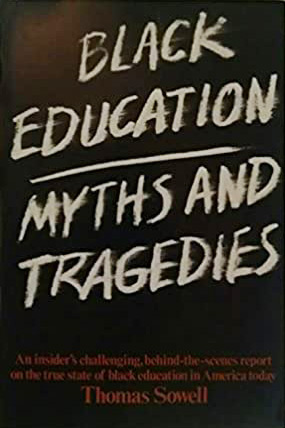 Black Education: Myths and Tragedies, by Thomas Sowell. David McKay Company, 1972.
Black Education: Myths and Tragedies, by Thomas Sowell. David McKay Company, 1972.
The Kirkus review says, “Sowell maintains that putting ill-prepared blacks, especially from the ghetto, into a high-pressure situation at top universities creates destructive frustrations and catalyzes self-consolatory militant separatism; but to compensate with black studies programs full of soft courses and lower standards is to cheat the student. This view is elaborated at circumstantial length, especially with reference to the 1969 Cornell upheavals. Sowell is severe toward those black administrators and teachers who in his view cover their mediocrity by playing campus politics and by spouting the rhetoric of blackness. He further argues that many able, industrious black students are being discriminated against by recruiters searching for the more ‘underprivileged’ albeit less gifted and he decries the tendency to dismiss working-class black families as ‘middle-class.’”
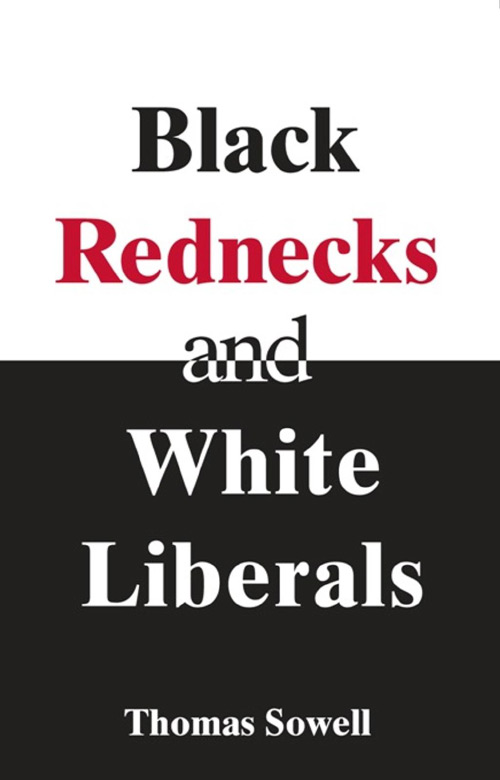 Black Rednecks and White Liberals, by Thomas Sowell. Encounter Books, 2006.
Black Rednecks and White Liberals, by Thomas Sowell. Encounter Books, 2006.
Includes the important case study of Dunbar High School in Washington DC, which was once an elite all-black school. Horace Mann Bond noted in 1970 that among blacks with a PhD, more came from Dunbar than any other high school in the country. After the 1954 Brown v. Board of Education decision, the school was reorganized as a neighborhood school and saw a decline in academic performance.
C. S. Lewis: An Apologist for Education, by Louis Markos. Classical Academic Press, 2015.
Publisher’s promotional material: “Lewis was a prescient observer of education and a thoughtful critic of modern educational theory and practice. In this brief book, Lewis scholar Dr. Louis Markos surveys Lewis's thought on education as represented in books such as The Abolition of Man, An Experiment in Criticism, The Discarded Image, Collected Letters,and numerous other essays and publications. What emerges is a timely call to renew a radical liberal arts education that assumes a meaningful, purposeful cosmos and that will awaken students from the slumber of cold vulgarity and cultivate their affections for truth, goodness, and beauty.”
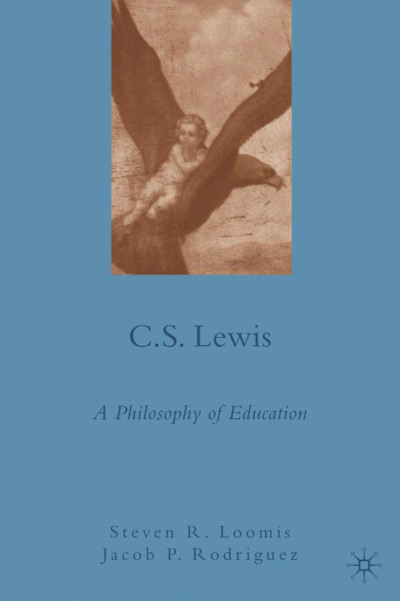 C.S. Lewis: A Philosophy of Education, by Steven Loomis and Jacob Rodriguez. Palgrave Macmillan, 2009.
C.S. Lewis: A Philosophy of Education, by Steven Loomis and Jacob Rodriguez. Palgrave Macmillan, 2009.
M.D. Aeschliman writes, “This book employs sophisticated philosophical, economic, and institutional analysis to show why the classical, liberal, and theistic tradition of educational philosophy, most tightly and eloquently articulated in our time by C.S. Lewis, must help to direct any really civilized, human educational reform project. Far from being a relic, this tradition may be the remnant that saves us from a vacuous and nihilistic post-human future. The authors have written a profound, powerful, important book deserving a very wide readership and influence.”
“Can Catholic Schools Be Saved?,” by Andy Smarick, National Affairs, no. 7 (Spring (2011): 113-130.
Smarick writes, “Over the years, a body of scholarly evidence has accumulated showing that Catholic schools have not only excellent academic results overall, but also a peculiar ability to help disadvantaged students. In the 1980s, the eminent sociologist James Coleman found that Catholic schools, more than public schools, were generating similar achievement results among different types of students. A decade later, other researchers reported similar results, finding that Catholic schools were somehow able ‘simultaneously to achieve relatively high levels of student learning [and] distribute this learning more equitably with regard to race and class than in the public sector.’ And in more recent years, many other researchers—including Paul Peterson, Derek Neal, and Andrew Greeley—have continued to find Catholic-school benefits (especially for at-risk students), including higher test scores, improved high-school graduation rates, and higher rates of college attendance. Catholic schools, in other words, somehow manage to narrow the ‘achievement gap.’ ...
“[Some researchers] argue that neither curriculum nor pedagogy is the principal reason Catholic schools achieve remarkable success with disadvantaged children. Rather, they note, it is because these schools are staffed by adults who believe unquestioningly that all children can and must learn, regardless of income, status, or race. Equally important is these adults' sense of responsibility and their determination to improve the lives of their students. The ‘soft bigotry of low expectations,’ prevalent in many troubled urban schools, has no place in Catholic education.
“Of course, many aging Baby Boomers who attended parochial schools might point to another of Catholic schooling's distinctive features. They likely recall memorization, recitation, a tightly ordered school day, lectures on diligence, and, most of all, discipline. Indeed, few would likely describe their childhood schools as the idealized learning environment embraced by today's progressive educators, where instruction is ‘student centered,’ where children can ‘explore,’ and where routine and repetition are abjured.”
Can Restorative Practices Improve School Climate and Curb Suspensions?: An Evaluation of the Impact of Restorative Practices in a Mid-Sized Urban School District, by Catherine H. Augustine, John Engberg, Geoffrey E. Grimm, Emma Lee, Elaine Lin Wang, Karen Christianson, and Andrea A. Joseph. RAND Corporation, 2018. Download PDF
Max Eden describes this randomized-control RAND study of “restorative justice” in a major urban district, Pittsburgh Public Schools. Eden says, “The results were curiously mixed. Suspensions went down in elementary but not middle schools. Teachers reported improved school safety, professional environment, and classroom management ability. But students disagreed. They thought their teachers’ classroom management deteriorated, and that students in class were less respectful and supportive of each other; at a lower confidence interval, they reported bullying and more instructional time lost to disruption. And although restorative justice is billed as a way to fight the ‘school-to-prison pipeline,’ it had no impact on student arrests. The most troubling thing: There were significant and substantial negative effects on math achievement for middle school students, black students, and students in schools that are predominantly black.”
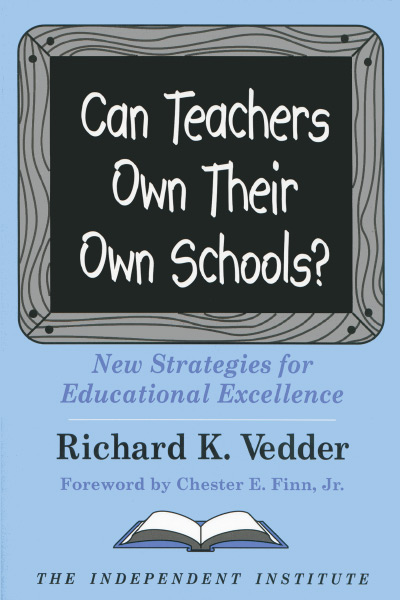 Can Teachers Own Their Own Schools? New Strategies for Educational Excellence, by Richard K. Vedder, foreword by Chester E. Finn, Jr. Independent Institute, 2000.
Can Teachers Own Their Own Schools? New Strategies for Educational Excellence, by Richard K. Vedder, foreword by Chester E. Finn, Jr. Independent Institute, 2000.
The Independent Institute's overview reads, “Drawing inspiration from Margaret Thatcher’s privatization of government council housing in England, privatization reforms in Latin America, and the E.S.O.P. [Employee Stock Ownership Plan] movement in the United States, Vedder presents a plan in which teachers, administrators and others involved in K-12 education would become the owners of schools, acquiring a financial stake in school success. Such privatization reforms could empower those directly involved and affected by school performance and end interest group barriers, paving the way for new, cost-effective means of improving educational outcomes. As a result, schools in which teachers, administrators, and parents have a significant financial stake would foster vibrant school communities with increased parental involvement and the innovation and efficiency essential to producing educational excellence.”
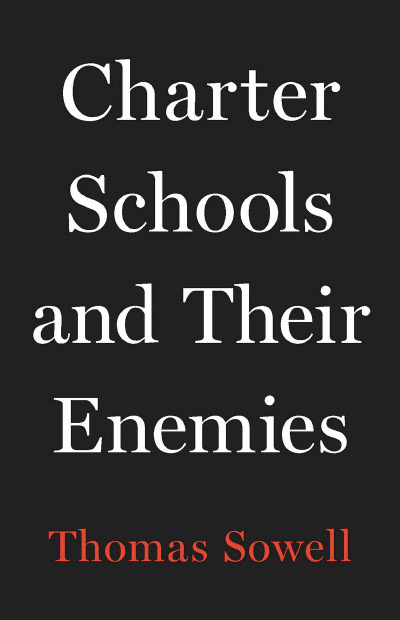 Charter Schools and Their Enemies, by Thomas Sowell. Basic Books, 2020.
Charter Schools and Their Enemies, by Thomas Sowell. Basic Books, 2020.
Sowell writes, “Schools exist for the education of children. Schools do not exist to provide iron-clad jobs for teachers, billions of dollars in union dues for teachers’ unions, monopolies for educational bureaucracies, a guaranteed market for teachers’ college degrees or a captive audience for indoctrinators.”
“The Children PISA Ignores in China,” by Tom Loveless. Brown Center Chalkboard blog, Brookings Institution, December 19, 2019.
The Chinese government’s selection of the provinces to be tested on international comparative tests distorts reality. Loveless writes, “[C]hildren living among 1.2 billion Chinese could not participate in [the Program for International Student Assessment (PISA)]. Much of that population lives in rural China, where the majority of China’s children are growing up. [The tested provinces of Beijing, Shanghai, Jiangsu, and Zhejiang], are highly urbanized provinces along the country’s east coast....
“Chinese authorities approve the provinces that participate in PISA. In 2015, Guangdong, rather than Zhejiang, had been the fourth participating Chinese province. Once Guangdong had been swapped out for Zhejiang, the 2018 scores from China shot up by at least 60 scale score points in the three PISA subjects, an unprecedented event....
“As Kam Wing Chan and other scholars of China have argued, there is not one but two Chinas: one urbanized, mainly on the east coast, and rapidly growing in wealth; the other rural, in the interior of China or on the move as migrants, and mired in poverty. (As a rough proxy, recent population numbers put the Chinese rural share at 41%). PISA assesses achievement of the first China and ignores the second one.”
"City Schools: Centralization of Control at the Turn of the Century,” by David B. Tyack. Printed in Building the Organizational Society: Essays on Associational Activities in Modern America, ed. by Jerry Israel. The Free Press, 1972: 57-72.
Tyack writes, “The centralist reforms at the turn of the [twentieth] century ... left legacies and... which still deeply influence urban education. ... The centralizers argued that educational government should be ‘above politics’ and that the notions of a ‘loyal opposition’ or partisan representation were out of place on school boards. ... A corollary of the myth of ‘nonpartisanship’ is that education should be entrusted to the professional experts. One consequence has been a general naivete – and sometimes obscurantism about the actual forces that shape education in this country.”
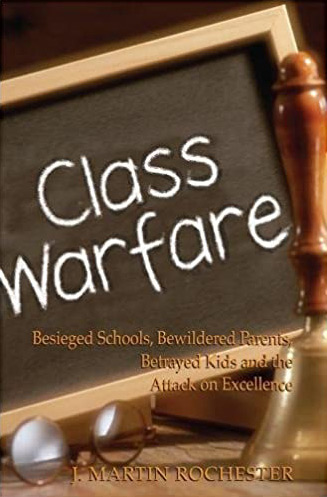 Class Warfare: Besieged Schools, Bewildered Parents, Betrayed Kids and the Attack on Excellence, by J. Martin Rochester, Encounter Books, 2002.
Class Warfare: Besieged Schools, Bewildered Parents, Betrayed Kids and the Attack on Excellence, by J. Martin Rochester, Encounter Books, 2002.
Rochester was at the time of the book’s writing a parent of school-age children as well as a political science professor at the University of Missouri. The book is based on his own experience battling for academic excellence in the face of opposition from authorities in suburban school districts outside St. Louis.
Rochester is a talented raconteur who tells how time and again he brought solid research on teaching methods to the attention of school officials, only to have them dismiss this serious research in favor of anecdotes gathered in a much less rigorous way by ed school professors.
Chester E. Finn Jr. writes, “Anyone under the illusion that America’s suburban public schools are doing fine and that our education crisis is confined to inner-city classrooms must read this book. Martin Rochester expertly reveals the mediocrity that afflicts the nation’s high-status suburban schools too [and] carefully shows how foolish education ideas are the chief culprits. ...”
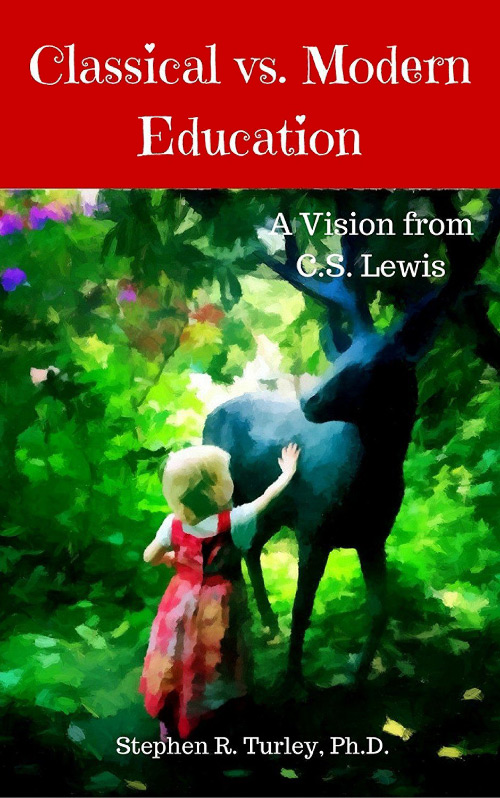 Classical vs. Modern Education: A Vision from C.S. Lewis, by Steve Turley. CreateSpace Independent Publishing Platform, 2017.
Classical vs. Modern Education: A Vision from C.S. Lewis, by Steve Turley. CreateSpace Independent Publishing Platform, 2017.
Publisher’s descriptive material: “Lewis explains that while the cultivation of virtue was central to classical education, modern education stifles such moral formation by teaching a scientifically-inspired mechanistic vision of the world. By rediscovering classical education, Lewis argues that the affections of our students can be trained to love what's truly lovely and thereby experience human flourishing.”
“Conflict and Consensus in American Public Education,” by David B. Tyack and Elisabeth Hansot. Daedalus, vol. 110, no. 3 (Summer, 1981): 1-25.
Tyack and Hansot write, “The creation of public education in the nineteenth century was based in large part on a belief system that John Higham calls a Protestant-republican ideology.... It had strong millennial elements shared by many of the Protestant sects.... The public school ... was to be the means of building a new order for the ages.... [T]he millennial vision of the Prestant-republican ideology gave coherence and resonance to the rhetoric of the common school crusaders....
“The older millennial vision of the [public education] pioneers was [later] subsumed under a new form of consensus in which management and scientific experts acquired an awesome power.... By the turn of the twentieth century, leadership in American public education had gravitated from the part-time educational evangelists of the mid-nineteenth century to a new breed of professional managers, ... who reshaped the schools according to the canons of ... efficiency and scientific expertise. Equally millennial in their own way, though rejecting or ignoring the theological content of the older millennialism, these leaders believed that science and new organizational arrangements would enable them to manage social progress....”
“A Conflict of Interest: District Regulation of School Choice and Supplemental Services,” by Paul E. Peterson. In Within Our Reach: Strengthening No Child Left Behind, ed. by John Chubb. Hoover Institution Press, 2005.
When the No Child Left Behind Act (2002) empowered parents whose children were stuck in failing schools to seek transfers or request supplemental tutoring, local school district officials resisted—both openly and passively—parental exercise of such choice options. Failing schools didn’t want to be labelled failing. And potential receiving schools didn’t want to face the challenge of teaching students who were behind. Local districts had the job and duty to oversee provision of tutoring services, but it was to be paid for with federal money that if it wasn’t spent on tutoring could be used by the district for other tasks. Districts therefore had an incentive to hide from parents the availability of tutoring, discourage its use, or insist that (despite their failures) the troubled districts themselves—and not outsiders—should provide the tutoring.
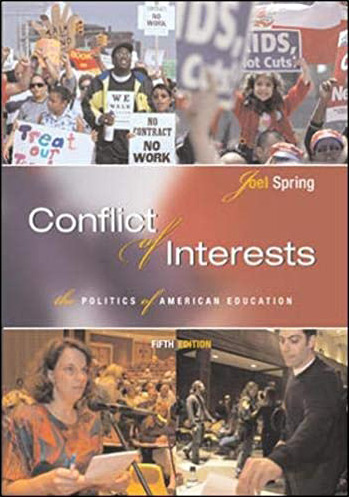 The Conflict of Interests: The Politics of American Education, by Joel H. Spring. 5th ed., Longman, 2004.
The Conflict of Interests: The Politics of American Education, by Joel H. Spring. 5th ed., Longman, 2004.
Longman: “Joel Spring argues that the politics of education is driven by a complex interrelationship between politicians, private foundations and think tanks, teachers' unions, special-interest groups, educational politicians, school administrators, boards of education, courts, and the knowledge industry.”
“The Curricular Smorgasbord,” by Williamson M. Evers and Paul Clopton. In Our Schools and Our Future: Are We Still at Risk?, ed. by Paul E. Peterson. Hoover Institution Press, 2003: 239-279. Download PDF
This article combines a consideration of the cafeteria-style curriculum of American high schools with a look at the intellectual history of Progressive Education (in an effort to explain why that cafeteria-style curriculum came about). Evers and Clopton write, “Armed with moralistic self-assurance, scientific-sounding rhetoric, and an anti-intellectualism inherited from the romantic movement, Progressive educators have consistently resisted academic rigor in the school classroom. Pioneering Progressive educators were born in a scientific age, often saw themselves as scientific and often wanted others to see them that way. But Progressive education’s roots in nineteenth-century pietist millennialism and in romanticism (which itself was rooted in an earlier millennialism) have made scientific habits of mind uncongenial to Progressive educators. Intellectual content has always been secondary to a program of remolding the child and the society.”
Dickens and Education, by Philip Collins, Macmillan, 1963.
Collins writes, “So far as [Dickens] has a controlling idea or vision of the infant mind and its development, one can parallel it completely in the more ‘progressive’ educational theorists known in England at that time – in such Continental leaders as Pestalozzi and Froebel, and such native propagandists as Robert Owen, William Lovett, and David Snowe. ...
“Clearly [Dickens had affinities, to say the least, with Romanticism, ... and in this he was at one with most of the novelists of his age who shared his social-reformist interests – they were Coleridgeans, not Benthamites or Augustans. ...
“The Romantic writers whom Dickens most admired and most demonstrably learned from is ...Carlyle. ... Hard Times, [Dickens’s] most ‘philosophical novel, and the one most concerned with education – was dedicated to him.”
“Does Competition among Public Schools Benefit Students and Taxpayers?” by Caroline M. Hoxby. American Economic Review, vol. 90, no. 5 (Dec. 2000): 1209-1238.
Hoxby argues that “Tiebout choice among districts is the most powerful [competitive] force in American public education.” She finds that “metropolitan areas with greater Tiebout choice have more productive public schools.” In other words, large all-encompassing public school districts in metropolitan areas like Los Angeles and Miami face less competitive pressure than fragmented regions with multiple districts like the Boston area.
“Does Universal Preschool Improve Learning? Lessons from Georgia and Oklahoma,” by Lindsey Burke. Heritage Foundation, May 14, 2009.
Burke writes, “[P]lans ... to introduce universal preschool are premised on a belief that such measures will improve education. As Congress considers expanding federal programs for early childhood education in order to encourage states to implement universal preschool, policymakers should examine the evidence on academic achievement from existing universal preschool programs.”
“E.G West: Economic Liberalism and the Role of Government in Education,” by James Tooley. (Bloomsbury Library of Educational Thought.) Bloomsbury Academic, 2008.
This volume is a reconsideration of the work of E.G. West, an historian of economic thought and of education. Tooley takes apart and reassembles West’s pioneering study Education and the State, which reexamined what had been achieved in education before state provision began. The argument in West’s book had hopscotched around a bit. Tooley evaluates the objections that have been raised to West’s argument and evidence. West’s book had reexamined what had been achieved in education before state provision began.
“Echo Chamber: The National Education Association’s Campaign Against NCLB,” by Joe Williams. Education Sector, July 2006.
Fordham Institute writes, “The National Education Association ... spent millions on public relations campaigns attacking [the No Child Left Behind act of 2002] since enactment. What the public doesn't know until now is that the NEA has also given millions of dollars in backchannel support to advocacy organizations, researchers, civil rights groups, and state political operatives to erode the federal law's legitimacy. In this report, Joe Williams details the support these groups and individuals received from the NEA to ‘echo’ and amplify the union's own criticisms of the law. A professor at Columbia University's Teachers College, who wished to remain anonymous because of his relationship with the union, said, ‘The [NEA] has a lot of money for research, but it wants the conclusions to match its agenda.’ For example, the Great Lakes Center for Education Research and Practice, a nonprofit outfit, has supported many studies critical of NCLB and high-stakes testing. According to Williams, ‘All [of those studies] have been funded entirely with money from the NEA and several state affiliates.’”
“The Economic Value of Higher Teacher Quality,” by Eric A. Hanushek. Working Paper 16606, National Bureau of Economic Research, 2010. Download PDF
From the author’s abstract: “Most analyses of teacher quality end without any assessment of the economic value of altered teacher quality. ... Replacing the bottom 5-8 percent of teachers with average teachers could move the U.S. near the top of international math and science rankings with a present value [in terms of student future earnings] of $100 trillion.”
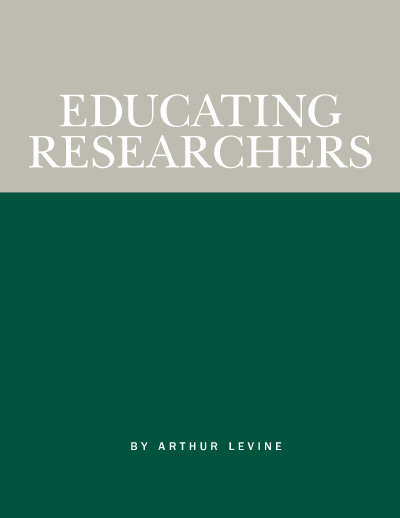 Educating Researchers, by Arthur E. Levine. Education School Project, 2007. Download PDF
Educating Researchers, by Arthur E. Levine. Education School Project, 2007. Download PDF
Levine, former president of Columbia University’s Teachers College, writes, “Education research is ... rated low by policymakers. ... [T]he volume of education research is so large as to be inaccessible and incomprehensible, yet so eclectic as to leave gaping holes in coverage. ... They criticized education research for differing reasons—impracticality, bias, self-promotion, inattention to implementation issues, gaps in content, inappropriate and ineffective methods of dissemination, low quality and weak methods, lack of replication and absence of rigor. All the groups desperately wanted education research and used it to varying degrees, but it was not having the impact on their policymaking it could or should have.”
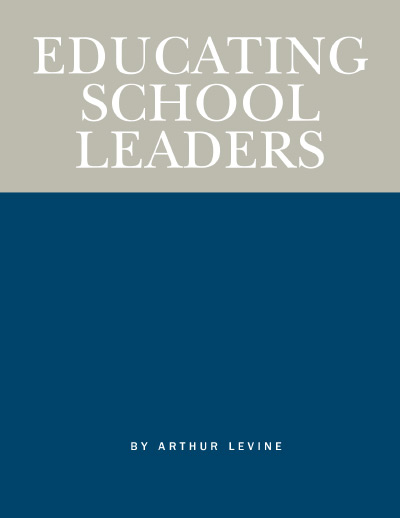 Educating School Leaders, by Arthur E. Levine. Education School Project, 2005. Download PDF
Educating School Leaders, by Arthur E. Levine. Education School Project, 2005. Download PDF
Levine, former president of Columbia University’s Teachers College, looks at leadership training programs for school principals and district superintendents. He finds that the bulk of the programs “range from inadequate to appalling, even at some of the nation's leading universities.” Levine writes, “Their curricula are disconnected from the needs of leaders and their schools. Their admission standards are among the lowest in American graduate schools. Their professoriate is ill-equipped to educate school leaders. Their programs pay insufficient attention to clinical education and mentorship by successful practitioners. The degrees they award are inappropriate to the needs of today's schools and school leaders. Their research is detached from practice.”
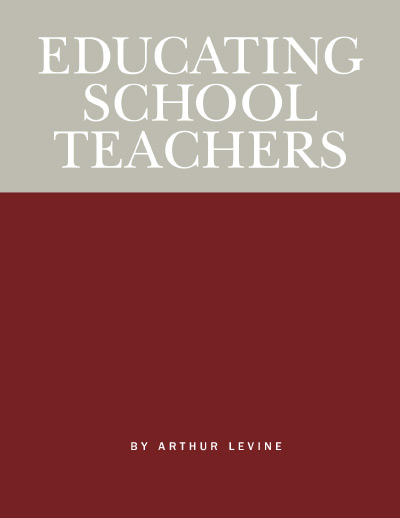 Educating School Teachers, By Arthur E. Levine. Education School Project, 2006. Download PDF
Educating School Teachers, By Arthur E. Levine. Education School Project, 2006. Download PDF
Levine, former president of Columbia University’s Teachers College, writes, “A Michigan State University meta-study found: ‘There is no research that directly assesses what teachers learn in their pedagogical preparation and then evaluates the relationship of that pedagogical knowledge to student learning or teacher behavior.’ There is also ‘no research that directly assesses prospective teachers’ subject matter knowledge and then evaluates the relationship between teacher subject matter preparation and student learning.’ ... “We don’t know what, where, how, or when teacher education is most effective. This means the education our teachers receive today is determined more by ideology and personal predilection than the needs of our children.”
Education and the Rise of the Corporate State, by Joel H. Spring. Beacon Press, 1973.
New Left historian of education Joel Spring writes, “By the end of the [nineteenth] century, many Americans believed ... future progress ... would result from cooperation not competition. ... One effect of this changing concept of social organization was the abandonment of a definition of individualism that stressed independence for a definition that included self-sacrifice and cooperation.
“In education, this changing image of society resulted in stressing the teaching of social cooperation and group work. Michael V. O’Shea, a professor of education at the University of Wisconsin, in 1909 summed up these new objectives of education as bringing the individual ‘into harmony with the customs, ideals, and institutions of present-day society. Intense individualistic feelings and actions must be brought under control, and cooperation must largely take [its] place.’ ... ”
Education and the State, by Eugenia F. Toma. In Public Choice Encyclopedia, ed. by Charles K. Rowley and Friedrich Schneider. Kluwer Academic Press, 2004.
A notable question in scholarly literature is “Are the benefits to schooling captured by the individual consumer or does society at large capture the benefits from schooling?” Toma parses the question, while describing how school choice and alternative financing schemes can address the externalities of the public school system, including how a better mix in students’ abilities and socioeconomic characteristics can help low-achieving students find success.
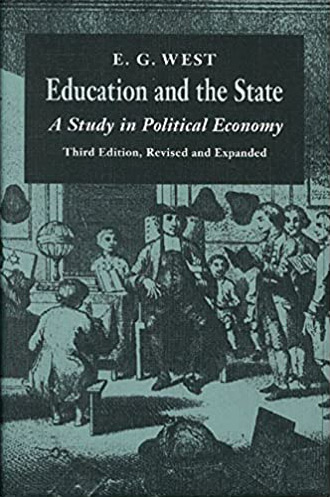 Education and the State: A Study in Political Economy, by E. G. West. 3rd. ed. Liberty Fund, 1994.
Education and the State: A Study in Political Economy, by E. G. West. 3rd. ed. Liberty Fund, 1994.
Charles Rowley writes, “Prior to this book, the conventional view of nineteenth and mid-twentieth-century education in Britain was that of the Hammonds, the Webbs, and the Coles, to the effect that democracy and education were inescapable partners. A free society could not be orderly unless it was literate. A self-governing society could not progress unless it was educated. Private schooling could not provide the quantity and quality of education required by these goals. Therefore, universal, compulsory and ‘free’ state-provided education was necessary. The Forster Act of 1870, which purported to initiate such an education system, and the English Education Act of 1944, which consolidated it, therefore, were both entirely justified.
“West demonstrated that this conventional wisdom was historically unsupported. He chronicled the significant growth of literacy in Britain during the first third of the nineteenth century. ... By 1838, 87 percent of children could read and 53 percent could write at least to some extent. These statistics, certainly for the ability to read, compare favorably with those for the United States at the turn of the 21st century if the requirement is literacy in the English language.
“Prior to 1870, education in England and Wales was provided primarily through private and parochial church schools financed by fee-paying parents and by church philanthropy. ... The principle of state subsidies to schools had been accepted only in 1833, by which time the above-mentioned high levels of literacy had already been achieved. ‘It seems reasonable, therefore, to infer that when the government made its debut in education in 1833, mainly in the role of subsidizer it was as if it jumped into the saddle of a horse that was already galloping,’ West wrote. There is no evidence that the Forster Act accelerated the rate of growth of education services, as measured in terms of school attendance or literacy, although it effectively initiated the displacement of private and parochial schools by state alternatives. According to West, the percentage of national income spent on schooling children under 11 years of age in 1833 was approximately the same as in 1965.”
“Education as a Form of Social Control,” by Joel Spring. In Roots of Crisis: Essays in Twentieth Century Education, ed. by Clarence J. Karier, Joel Spring, and Paul C. Violas. Rand McNally, 1973, pp. 30-39.
For our purposes, the first part of the essay (on American sociologist Edward A. Ross’s ideas of using public education for social control) is more important than the second part (on intelligence testing). Spring writes, “Ross, writing from the perspective of the 1890s ... [argued that] reliance on education as a new means of control was in fact exactly what was becoming a characteristic of American society. More and more the school was taking the place of the church and the family. ... And the advantage of the school over the home as a means of control lay in the fact that a public official was substituted for the parent. ...
“The schools in the early part of the twentieth century were ... expanding their responsibilities to act as effective instruments of control. It became common to say that that school was responsible for the whole child, which meant it had responsibility for all the child’s activities. This naturally led to the idea that the school should expand its custodial functions beyond the classroom to include the child’s entire social life. Play, dancing, and hobbies were to fall under the umbrella of schooling.”
“The Education Iron Triangle,” by Paul E. Peterson, Martin R. West, and Michael Henderson. The Forum, vol. 10, no. 1 (2012). Download PDF
The authors write, “Iron triangles lie at the heart of the textbook theory of American politics. Producer interest groups—farmers, gas and oil barons, banks, auto companies, real estate firms, nuclear energy plants and the like—all build relations with elected officials who oversee the regulatory and operating agencies relevant to the industry’s wellbeing. Implicit in iron triangle theory is the notion that the interests and policy preferences of those inside the triangle differ from those of the general public. Producer groups succeed in insulating policy decisions from external pressures, because they have the focus and resources to pursue their goals effectively, while the attention of the general public is too episodic and scattered to have an impact, except in times of crisis. ... Ordinarily, the iron triangle operates quietly—at the public’s expense. Curiously, iron triangle theory is seldom applied to school politics.” From the abstract: “[S]chool politics [turns out to be] largely a conflict between producers within the system and consumers outside it—a classic iron triangle theme.”
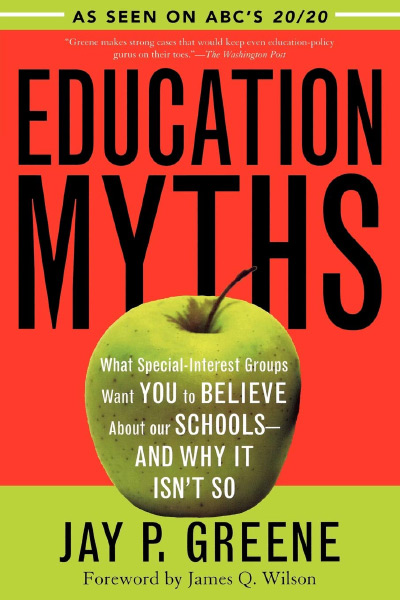 Education Myths: What Special Interest Groups Want You to Believe about Our Schools and Why It Isn’t So, by Jay P. Greene. Rowman & Littlefield, 2005.
Education Myths: What Special Interest Groups Want You to Believe about Our Schools and Why It Isn’t So, by Jay P. Greene. Rowman & Littlefield, 2005.
ERIC summarizes this book as follows: “In this book, Jay P. Greene [has] gathered the evidence to show that much of what people believe about education policy is little more than a series of myths. Greene takes on the conventional wisdom and closely examines eighteen myths advanced by the special interest groups dominating public education. In addition to the money myth, the class size myth, and the teacher pay myth, Greene debunks the special education myth (special ed programs burden public schools), the certification myth (certified or more experience teachers are more effective in the classroom), the graduation myth (nearly all students graduate from high school), the draining myth (choice harms public schools), the segregation myth (private schools are more racially segregated), and several more. Greene’s reasoned and accessible approach identifies the myth and then refutes it with relevant and reliable facts and figures—including the education establishment’s own research.”
“Education Reform’s Deep Blue Hue,” by Jay P. Greene and Frederick M. Hess, Education Next, March 11, 2019.
The analysis shows that education-reform scholars give 96% to Democratic candidates, and recipients of grants from the Gates and Walton foundations give 99% to Democrats. Such homogeneity means education reformers are usually clueless about or unreceptive to conservative and libertarian concerns and are ill equipped to make alliances across political aisles. Greene and Hess write: “The leading participants in the school-reform ‘wars’ are mostly engaged in an intramural brawl, one between union-allied Democrats and a strand of progressive Democrats more intent on changing school systems.”
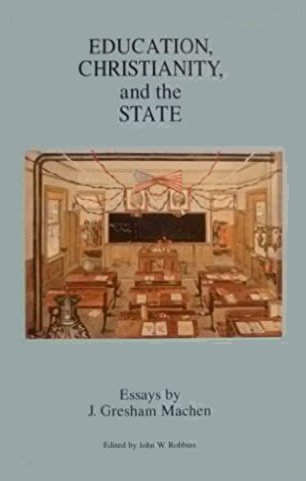 Education, Christianity, and the State: Essays, by J. Gresham Machen, ed. by John W. Robbins. 2nd rev.ed., Trinity Foundation, 2004.
Education, Christianity, and the State: Essays, by J. Gresham Machen, ed. by John W. Robbins. 2nd rev.ed., Trinity Foundation, 2004.
D.T. Kleven writes, “This book is a collection of addresses that Machen gave back in the 1920s on the current state of the nation, particularly as related to Christianity, education, the state and how the three are intertwined. Machen is something of a Christian libertarian/constitutionalist. He argues in favor of a strict constitutional limitation on the federal government, particularly in the area of education. These were days when a Department of Education was being proposed, and Machen was vehemently opposed to it. My favorite chapter is Chapter 7 which contains the transcript of Machen testifying before congress against the proposed DoE. He is in favor of as much competition between public and private schools as possible. He doesn’t want public schools teaching morality at all, because they always teach a false morality, and fears the dumbing down of an entire nation in which uniformity is forced upon everyone.”
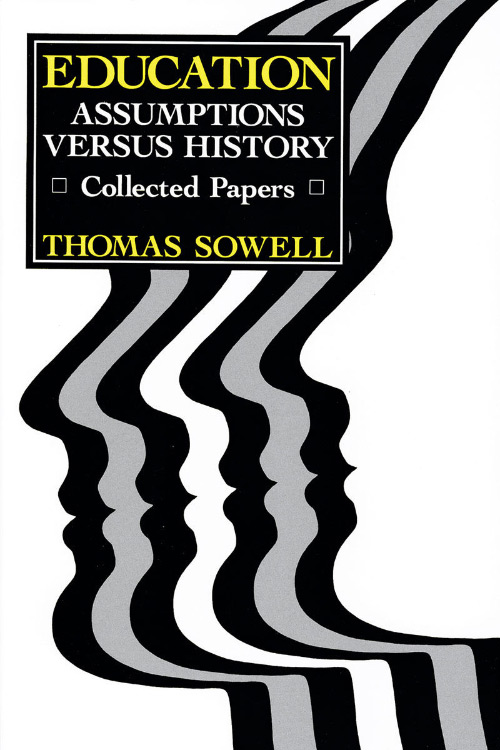 Education: Assumptions Versus History, Collected Papers, by Thomas Sowell. Hoover Institution Press, 1986.
Education: Assumptions Versus History, Collected Papers, by Thomas Sowell. Hoover Institution Press, 1986.
Publisher’s publicity material: “Sowell discusses the controversies surrounding affirmative action, race and IQ, tuition tax credits and academic tenure. The experiences of blacks and other ethnic groups in the American education system are examined closely to identify the factors and patterns behind both success and failure.” The book includes a discussion of eight high-performing black K-12 schools.
Education: Free and Compulsory, by Murray N. Rothbard. Ludwig von Mises Institute, 1999. Download PDF
This short book is a philosophical analysis and historical account of compulsory education. Rothbard writes that, for example, “in Athens, the original practice of compulsory state education later gave way to a voluntary system. In Sparta, on the other hand, an ancient model for modern totalitarianism, the State was organized as one vast military camp, and the children were seized by the State and educated in barracks to the ideal of State obedience. Sparta realized the full logical conclusion of the compulsory system; absolute State control over the ‘whole child’; uniformity and education in passive obedience to State orders. The most important consequence of this system was that it provided the ideal for Plato, who made this educational system the basis of his ideal State, as set forth in the Republic and the Laws. Plato’s ‘Utopia’ was the first model for later despotisms—compulsory education and obedience were stressed, there was ‘communism’ of children among the elite ‘guardians’ who also had no private property, and lying was considered a proper instrument for the State to use in its indoctrination of the people.”
“Education: The Path from Centralization to Privatization,” by Eugenia F. Toma. In Federalist Government in Principle and Practice, ed. by Donald P. Racheter and Richard E. Wagner. Springer Science and Business Media, 2001, pp. 193-209.
Toma writes, “Suppose one [school] district chooses a pedagogy that involves child-centered, or individual learning styles. Another district chooses a traditional, one lecture for all students, pedagogical approach. ... The consumers of jurisdiction A may believe strongly that the teaching style promoted in jurisdiction B is an inefficient pedagogy and, therefore, an inefficient use of their money [collected through state taxes]. If a sufficient number of jurisdictions agree with jurisdiction B, they will have an incentive to form a coalition and go to the state level of government to restrict the ability of jurisdiction A to use its most preferred pedagogy. ... This simple illustration depicts the dilemma created by centralized funding of schools.
“Educational Slowdown and Public Intervention in 19th-Century England: A Study in the Economics of Bureaucracy,” by E.G. West, Explorations in Economic History, vol 12 (1975): 61–87. Download PDF
West “applies hypotheses from the modern economics of bureaucracy” to explain the strategy of the Victorian-era Education Department in Britain. He shows how “its discretionary behaviour led to the ‘crowding out’ of private schools.”
“The Effect of Curriculum-Based External Exit Exam Systems on Student Achievement,” by John H. Bishop, Journal of Economic Education, vol. 29, no. 2 (Spring 1998): 171-182. Download PDF
From the abstract: "It is claimed that curriculum-based external exit exam systems based on explicit content standards will improve the teaching and learning of core subjects. What evidence is there for this claim? Outside the United States, such systems are the rule, not the exception. What impacts have such systems had on school policies, teaching, and student learning?”
Herbert J. Walberg writes, “Curriculum-based external examinations need not be produced or commissioned by government authorities. For-profit and not-for-profit companies could, and on a small scale already do, compete to provide [them].”
“‘Every Catholic Child in a Catholic School’: Historical Resistance to State Schooling, Contemporary Private Competition and Student Achievement Across Countries,” by Martin R. West and Ludger Wößmann. Economic Journal vol. 546, whole no. 120 (2010): F229-F255. [Download PDF of Institute for Economic Research at the University of Munich Paper, 2008.]
Abstract: “Nineteenth-century Catholic doctrine strongly opposed state schooling. We show that countries with larger shares of Catholics in 1900 (but without a Catholic state religion) tend to have larger shares of privately operated schools even today. We use this historical pattern as a natural experiment to estimate the causal effect of contemporary private competition on student achievement in cross-country student-level analyses. Our results show that larger shares of privately operated schools lead to better student achievement in mathematics, science and reading, and to lower total education spending, even after controlling for current Catholic shares.”
“The Evidence on Class Size,” by Eric A. Hanushek. In Earning and Learning: How Schools Matter, ed. by Susan E. Mayer and Paul E. Peterson. Brookings Institution, 1999, pp. 131-168. [Download PDF of University of Rochester Occasional Paper, 1998.]
Author’s abstract: “No topic in education has received such public and professional attention as class size. Calls for reductions in class sizes are rallying points for parents, teachers, and administrators across the nation, and politicians have rushed to claim credit for introducing policies aimed at reducing class size. The pupil-teacher ratio in a school district, for example, is frequently used as the fundamental metric for quality, and comparisons across districts become indexes of equity. A prime reason for the attention to class size is that it represents such an extremely convenient policy instrument, one amenable to general political action. A legislature or a court, wishing to alter student outcomes, can easily specify a change in a class size, whereas other potential changes are much more difficult to effect.”
"An Explanation for Public Provision of Schooling: The Importance of Indoctrination," by John R. Lott Jr. Journal of Law and Economics, vol. 33, no.1 (April 1990): 199-231. Download PDF
Lott argues that government-provided schooling lowers the cost to political decision-makers of taking from some and granting to others by instilling views supportive of such transfers. He writes, “The greater the perceived ‘legitimacy’ or ‘fairness’ of existing transfers, the lower the opposition. When the cost of pro-transfer information falls and that of anti-transfer information rises, views more favorable to the government are generated. Government-provided schooling, like a government-owned news media, is used to decrease the cost of wealth transfers by changing the relative cost of acquiring different information and by predisposing students to support certain transfers. To instill the desired views, public teachers are given rents, and the possible threat of losing such rents serves as an incentive for the teachers to conform to the objectives set by the politicians. Further, the teachers are shielded from competition through the use of exclusive territories. If vouchers were used, the competition for students by teachers would underproduce the indoctrination not individually valued by consumers.”
“The Failure of Input-Based Schooling Policies,” by Eric A Hanushek. The Economic Journal, vol. 113, whole no. 485 (2003): F64-F98. Download PDF
It’s a shibboleth of the education field that money per se is what matters in public-school improvement. Hanushek demolishes that claim. From the abstract: “In an effort to improve the quality of schools, governments around the world have dramatically increased the resources devoted to them. By concentrating on inputs and ignoring the incentives within schools, the resources have yielded little in the way of general improvement in student achievement. This paper provides a review of the U.S. and international evidence on the effectiveness of such input policies. It then contrasts the impact of resources with that of variations in teacher quality that are not systematically related to school resources. Finally, alternative performance incentive policies are described.”
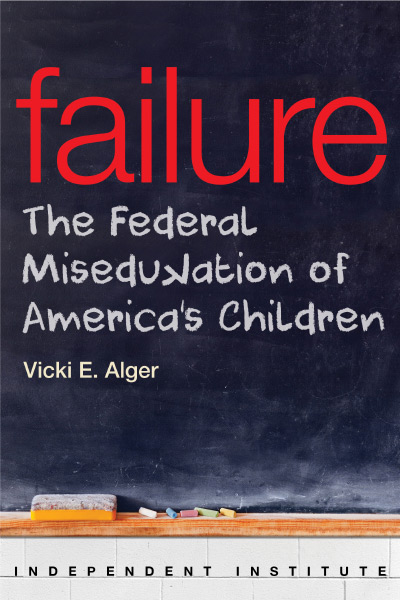 Failure: The Federal ‘Misedukation’ of America’s Children, by Vicki E. Alger. Independent Institute, 2016.
Failure: The Federal ‘Misedukation’ of America’s Children, by Vicki E. Alger. Independent Institute, 2016.
Since the 1979 creation of the Department of Education, federal involvement in education has only resulted in high spending and low performance. Federal efforts in K-12 education have failed educators, parents, and students alike. Here’s the evidence, with full documentation.
Federal Overreach and Common Core, by Williamson M. Evers. Pioneer Institute for Public Policy Research, 2015. Download PDF
Evers writes that despite the fact that “three federal statutes prohibit the [U.S.] Department of Education from exercising ‘any’ direction, supervision, or control over curriculum or the program of instruction in the states, ... the Department of Education funded the national assessments and gave privileged status to the Common Core curriculum standards and strongly incentivized states to adhere to the Common Core.”
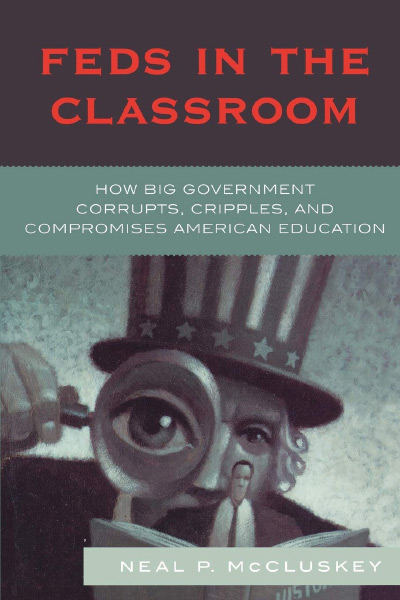 Feds In The Classroom: How Big Government Corrupts, Cripples, and Compromises American Education, by Neal McCluskey. Rowman & Littlefield Publishers, 2007.
Feds In The Classroom: How Big Government Corrupts, Cripples, and Compromises American Education, by Neal McCluskey. Rowman & Littlefield Publishers, 2007.
Rowman & Littlefield: “[T]he federal government ... has drilled deep into almost every public classroom in America. Washington can now tell public schools whether their teachers are qualified, their reading instruction acceptable, and what they must do when their students do not achieve on par with federal demands. ... [T]he federal government can dictate what will be taught, when, and by whom, to most of the 15,000 public school districts and 47 million public school children. ... [W]ith the almost‐complete consolidation of education authority in the hands of policy makers in Washington, the last of our educational liberty has been pushed to the brink of extinction.”
Fixing Special Education, by Jay P. Greene. Peabody Journal of Education, vol. 82, no. 4 (October 2007): 703-723. Download PDF
Pouring much more federal money into education of the learning-disabled would lead to distortions and perverse incentives. To get as much money as possible, districts would surely over-identify learning-disabled students. Such over-classification would expand special-education programs that don’t need to be expanded, waste money on students who don’t need special education, mismatch students to programs they don’t belong in, and stigmatize children by mislabeling them.
ERIC: The current system of educating disabled students provides financial incentives to schools to overidentify students as disabled and underserve those [who] are identified. The incentive to overidentify is caused by providing schools with additional funds as more students are placed in special education categories that are ambiguous to diagnose and require relatively low additional expenditures to address. The incentive to underserve is caused by high information and transaction costs imposed on parents using the legal process to obtain desired services.
Forgotten Heroes of American Education: The Great Tradition of Teaching Teachers, ed. by J. Wesley Null and Diane Ravitch. Information Age Publishing, 2006.
Martin A. Davis Jr. writes, “Diane Ravitch, American education’s foremost historian, ... and Wesley Null, a young, reform-minded education professor, are the perfect pair to re-introduce the world to eight educators who long ago foresaw the dangers of ‘progressive’ education. Those men-Bagley, DeGarmo, Felmley, Harris, Kandel, McMurry, Ruediger, and Sheldon-are all but unknown today, Ravitch says, ‘because in the great pedagogical battles of the twentieth century, they lost.’ They believed ‘in the importance of preparing excellent teachers for our schools’ and ‘should not have been forgotten.’
“The rueful tone of Ravitch’s foreword is balanced by Null’s fire-breathing introduction. ‘The profession of teaching will continue to decline unless its leaders-especially the profession’s younger leaders-read and learn from the authors who produced the essays that are found in this volume.’ ... The soul of teaching, Null argues, has been shattered. ‘The time has long passed,’ he says, ‘for us to work together to make it whole again.’
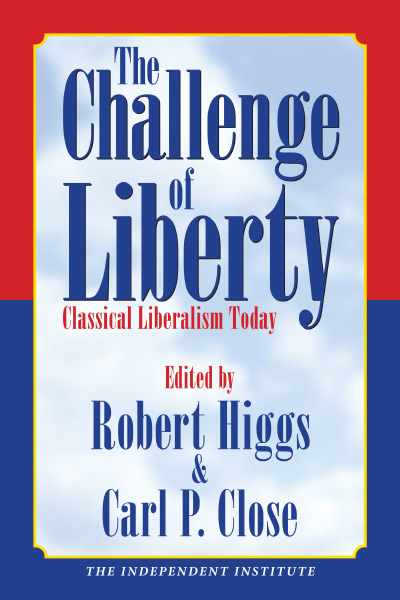 “Freedom of Religion and Public Schooling,” by James R. Otteson. In The Challenge of Liberty: Classical Liberalism Today, ed. by Robert Higgs and Carl P. Close. Independent Institute, 217-223, 2006.
“Freedom of Religion and Public Schooling,” by James R. Otteson. In The Challenge of Liberty: Classical Liberalism Today, ed. by Robert Higgs and Carl P. Close. Independent Institute, 217-223, 2006.
Otteson writes, “If it would be wrong for the government to adopt an official religion, then, for the same reasons, it would be wrong for the government to adopt official education policies. The moral case for freedom of religion stands or falls with that for freedom of education. A society that champions freedom of religion but at the same time countenances state regulation of education has a great deal of explaining to do.”
“From Voluntarism to Bureaucracy in American Education,” by Michael B. Katz. Sociology of Education, vol. 44, no. 3 (Summer 1971): 297-332.
New Left historian Katz discusses four early models of providing education in the United States: (1) Charity Organization Society-style voluntarism; (2) ward-based local public elementary schools; (3) private academies and colleges; and (4) bureaucratic control under citywide boards of education.
Getting Down to Facts: School Finance and Governance in California, by Susanna Loeb, Anthony S. Bryk, and Eric A. Hanushek. Institute for Research on Education Policy and Practice, Stanford University, 2007. Download PDF
In this detailed study of school finance in California, Loeb, Bryk, and Hanushek write: “The relationship between dollars and student achievement in California is so uncertain that it cannot be used to gauge the potential effect of resources on student outcomes. [If you plot] district [Academic Performance Index] scores as a function of per pupil spending in 2004-2005, [there is] essentially no relationship between the two. ... [B]ecause of the inefficiencies in the governance system, there may, in fact, be little relationship between dollars and student outcomes. If this were the case, more money in the current system without significant reforms would be unlikely to result in students meeting challenging state standards. ... If additional dollars were inserted in the current system, there is no reason to expect substantial increases in student outcomes related to state goals.”
 Government Failure: E.G West on Education, ed. by James Tooley and James Stanfield. Institute of Economic Affairs, 2003.
Government Failure: E.G West on Education, ed. by James Tooley and James Stanfield. Institute of Economic Affairs, 2003.
Institute of Economic Affairs: “Perhaps the most valuable contribution of [this selection of E.G. West’s papers] is their historical analysis. The extent to which education systems developed in the UK and the USA before either compulsory schooling or dominant state finance emerged is remarkable. E.G. West also analyzes the debate between those who believe that the state should control education in order to shape the thinking of the younger generation, and those who believe in a pluralist system.”
“High-Spending, Low-Performing School Districts,” by Williamson M. Evers and Paul Clopton. In Courting Failure: School Finance Lawsuits Exploit Judges’ Good Intentions and Harm our Children, ed. by Eric A. Hanushek. Education Next Books, 2006, pp: 103-94. Download PDF
The authors write, “Do school districts, as presently constituted, have the capacity to succeed academically with low-performing students? Are school districts organized in a way that ensures they are making productive use of the money they now receive from taxpayers or of the additional money they would receive if adequacy campaigns prevailed? ... Unless school districts as currently constituted have the needed capacity for productivity, channeling large amounts of additional money to those districts will not succeed in boosting student achievement.” The authors put “five school districts under the microscope: Kansas City, Missouri; Washington, D.C.; Cambridge, Massachusetts; Newark, New Jersey; and Sausalito, California. Though these districts are high-spending, they are also low-performing.”
“How Teachers’ Unions Affect Education Production,” by Caroline M. Hoxby. Quarterly Journal of Economics, vol. 111, no. 3 (August 1996): 671-718. Download PDF
Abstract: “This study helps to explain why measured school inputs appear to have little effect on student outcomes. ... Teachers’ unionization can explain how public schools simultaneously can have more generous inputs and worse student performance. ... I find that teachers’ unions increase school inputs but reduce productivity sufficiently to have a negative overall effect on student performance. Union effects are magnified [when schools face less competition; that is, when residents of school districts are less likely to react to increased or reallocated school spending by moving to another district].”
“How Within-District Spending Inequities Help Some Schools to Fail,” by Marguerite Roza, Paul T. Hill, Susan Sclafani, and Sheree Speakman. Brookings Papers on Education Policy, no. 7 (2004): 201-27. Download PDF
Public schools serving low-income children get less qualified teachers than schools in the same local district serving children from higher-income households. This paper focuses on how the financing of this discrepancy is hidden in “budget layering” and in how district spending is reported to the public. Differences in per-pupil spending are “masked by teacher salary cost-averaging.”
“How Woodrow Wilson Denied African-Americans an Academic Education,” by Williamson M. Evers. Education Week, December 9, 2015.
Evers writes, “In this project, the Wilson administration worked with a leading figure from the world of philanthropy, Thomas Jesse Jones. . . . He was the author of the [federal] report “Negro Education” that said that African-Americans should only have a vocational, non-academic education. ... Jones, of course, was hardly the only progressive intellectual at the time to advocate a vocational-only education for African-Americans. Other prominent progressives who did so include Walter Hines Page, Ray Stannard Baker, President Theodore Roosevelt, and John Dewey. In Schools of Tomorrow (1915), Dewey and his daughter Evelyn depict an all-African-American vocational school in Indianapolis in which young people had an almost entirely non-academic curriculum. Then the Deweys contend that such an education was appropriate for children from African-American and immigrant households.”
“If Families Matter Most, Where Do Schools Come In?” by Caroline M. Hoxby. In A Primer on America’s Schools, ed. by Terry M. Moe. Hoover Institution Press, 2001. Download PDF
Hoxby writes, “Most people believe that a child’s family is the most important determinant of his or her life outcomes—not just family-related outcomes like marriage but also achievement outcomes like test scores, whether the child graduates from college, and wages later in life. Most people are right: the widespread belief in families’ importance is amply supported by statistical evidence. ... Nonfamily influences on children have much less powerful effects on childrens’ outcomes—by at least an order of magnitude. ... [I]t is wrong to think of families and schools as alternative influences on children—so that, if families are important, schools are not. In fact, one of the ways in which ‘good’ families benefit their children is by choosing good schools for them. On the one hand, it is right to attribute this ‘good school’ effect to families because school quality is a resource that they choose to provide (like nutritious meals or comfortable living space). ... [W]ell-planned school reforms can exploit the power of families, making their influence better. Essentially, the logic of such a reform is to improve parents’ influence by giving them incentives to be better, more informed, more active consumers of education. Reforms can also make parents better consumers by eliminating arbitrary constraints on their choices. Finally, a reform can improve parents’ effects by raising their incentives to make investments in their children’s education that are complementary to schools.
“An example unrelated to schools may help with the essential logic. Families produce good nutritional status by being good consumers at the grocery store and by preparing food wisely. If a change in the grocery store industry—say, better labeling of food and availability of nutritious recipes—made families into better grocery consumers and better producers of meals, nutritional status would increase. The improvement in nutrition would take place even though the vast majority of nutritional status was determined within the family, both before and after the change in the industry. This chapter is about the links between families and schools. I explore the importance of families for children’s outcomes, paying particular attention to the school-related channels through which family effects work. I also describe how family effects work better under some schooling institutions than under others.”
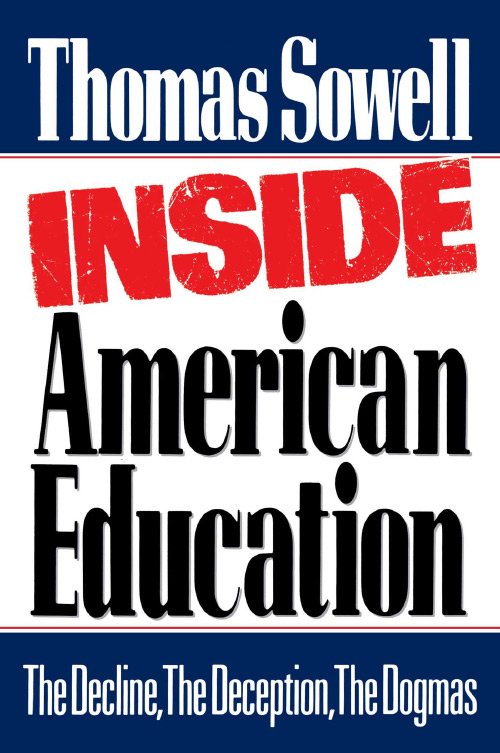 Inside American Education: The Decline, The Deception, The Dogmas, by Thomas Sowell. Free Press, 2003.
Inside American Education: The Decline, The Deception, The Dogmas, by Thomas Sowell. Free Press, 2003.
Sowell takes on a variety of K-12 educational fads that came to the fore in the United States during the 1960s and later. He points to the lack of rigor in ed[ucation] schools and their embrace of fads. Specifically, he criticizes “Man: A Course Study,” a federally funded and promoted curriculum in the social and behavioral sciences. Sowell likewise criticizes the “values clarification” approach to character and moral education. Sowell writes that in “values clarification,” values are downgraded to subjective preferences of individuals or blind traditions of ‘our society,’ and contrasted with alternative values of other individuals and other societies—including, in some cases, the societies of various species of animals. The ‘nonjudgmental’ approach which pervades such exercises provides no principle of logic or morality by which to choose among the many alternatives presented—except, implicitly, what ‘peers’ or ‘experts’ or ‘modern thinking’ might prefer.” Sowell also includes criticism of higher education in this volume.
“The Institute of Education Sciences: New Wine, New Bottles,” by Grover J. Whitehurst. Paper presented at the American Educational Research Association 2003 Annual Meeting, April 22, 2003. Download PDF
Whitehurst, who was the first director of the federal government’s Institute of Education Sciences, talks about the mission and activities of the Institute during the George W. Bush administration, including its emphasis on randomized trials of interventions. He then provides his quite valuable reflections on “the fit, and sometimes misfit,” between the education research community’s current activities and the needs of practitioners and policy makers.
Whitehurst writes, “[T]here is a mismatch between what education decision makers want from the education research and what the education research community is providing. The people on the front lines of education want research to help them make better decisions in those areas in which they have choices to make, such as curriculum, teacher professional development, assessment, technology, and management. These are questions of what works best for whom under what circumstances. These are questions that are best answered by randomized trials of interventions and approaches brought to scale. These are questions and methods and development efforts with which relatively few in the education research community have been engaged. The people on the front lines of education do not want research minutia, or post-modern musings, or philosophy, or theory, or advocacy, or opinions from education researchers.”
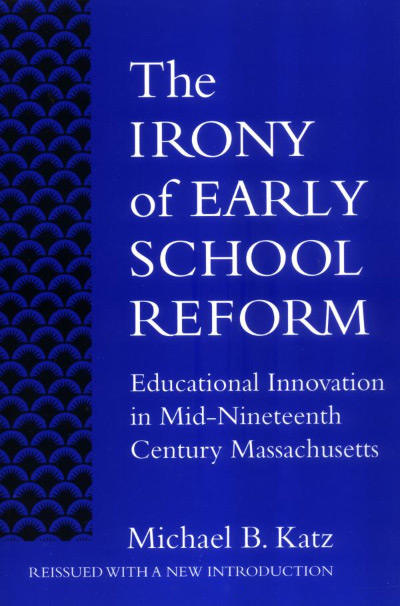 The Irony of Early School Reform: Educational Innovation in Mid-Nineteenth Century Massachusetts, by Michael B. Katz. Harvard University Press, 1968. Download PDF
The Irony of Early School Reform: Educational Innovation in Mid-Nineteenth Century Massachusetts, by Michael B. Katz. Harvard University Press, 1968. Download PDF
J. Stephen Hazlett writes, “[Katz] revises a commonly offered view that education reform was sponsored by enlightened humanitarians in response to the appeals of a working class which desired expanded educational opportunities. He sets this notion on its head and argues instead that a genteel coterie of reformers, sharing common values and perceptions of society, essayed to ‘remake the rest of mankind in their own image.’ ...”
“The Irrational Fear of For-Profit Education,” by Frederick M. Hess. Wall Street Journal, Dec. 17, 2012.
Frederick Hess, resident scholar at the American Enterprise Institute, points out that for-profits are more efficient and innovative than nonprofits, because they are disciplined by the alert eyes of investors who are looking for the best place to put their money. For-profits are in a better position to offer employees highly remunerative long-term job opportunities and can draw on large funds raised in private-equity markets. Nonprofits, Hess notes, have “little incentive” to become early adopters of new and potentially more effective practices. New practices are all too often anathema in nonprofits because they make waves and upset staff routines.
“Is Public Schooling a Public Good? An Analysis of Schooling Externalities,” by Corey DeAngelis, Cato Institute Policy Analysis, no. 842, May 9, 2018. Download PDF
De Angelis writes, “The formal definition of a public good is attributed to Nobel laureate economist Paul Samuelson. In a classic 1954 article he explained that such a good satisfies two necessary conditions: (1) it is nonexcludable, and (2) it is nonrivalrous in consumption.
The nonexcludability provision means that the producer cannot prevent nonpayers from using the good without bearing costs that exceed the benefit of payment. This provision is important because nonexcludability leads to a potential free-rider problem: individual consumers can enjoy the benefits of a product without directly paying for it. ... The nonrivalry provision simply means that one individual’s consumption of the good does not diminish the abilities of others to consume it. A radio station can be thought of as a true public good. Because it would be extremely difficult to prevent anyone with a radio from listening, the good is considered nonexcludable. And because one person’s consumption of the service does not affect whether the rest of society can listen, the radio is considered nonrivalrous. ...
[S]chooling easily fails both parts of the economic definition. If one student occupies a seat in a classroom, another child is prevented from sitting in the same seat. In addition, if students are added to a given classroom, the teacher is less able to tailor the educational approach to each child, which could reduce the average amount of personalized education received by each student. Because of this, schooling fails the nonrivalrous part of the definition. Second and perhaps most important, because it is not difficult to exclude a person from a school—or any other type of institution with walls—schooling fails the nonexcludability condition. If someone does not pay me to educate the student, I can simply deny the student services. Fortunately, schools will never suffer from a true free-rider problem because they are not true public goods.”
“Is the Public School Obsolete?,” by Christopher Jencks. The Public Interest, Winter 1966: 18-27. Download PDF
Jencks writes, “[S]o far as the slum child is concerned, the present system of ‘socialized education’ has failed, and ... some kind of new departure, either ‘capitalist’ or ‘syndicalist,’ is needed. Either tuition grants or management contracts to private organizations would, of course, ‘destroy the public school system as we know it.’ ... [W]e must not allow the memory of past achievements to blind us to present failures. Nor should we allow the rhetoric of public school men to obscure the issue. It is natural for public servants to complain about private competition. ... But if the terms of the competition are reasonable, there is every reason to suppose that it is healthy. ... And if, as some fear, the public schools could not survive in open competition with private ones, then perhaps they should not survive.”
“It’s Easier to Pick a Good Teacher Than to Train One: Familiar and New Results on the Correlates of Teacher Effectiveness,” by Matthew M. Chingos and Paul E. Peterson. Economics of Education Review, vol 30, no. 1 (2011): 449-465.
Neither holding a college major in education nor acquiring a master’s degree is correlated with elementary and middle school teaching effectiveness, regardless of the university at which the degree was earned.
“J. Gresham Machen: A Forgotten Libertarian,” by Daniel F. Walker, Foundation for Economic Education, December 1, 1993.
Walker writes, Long before the federal Department of Education was finally created in the 1970s, efforts had been made to establish it in the 1920s. Machen vigorously opposed those efforts in published letters, essays in national magazines, speaking engagements, and in an appearance before a joint Congressional committee. There, Machen warned against government control over young people: “If you give the bureaucrats the children, you might as well give them everything else as well.”
“J. Gresham Machen: God’s Forgotten Libertarian,” by Lawrence W. Reed, FEE Daily, Foundation for Economic Education, 2015.
Reed writes, “[Machen] objected to Bible reading and prayer in public schools because they mixed politics with faith; Christians, he said, should form their own schools. He believed it was foolish to think that government would be anything but a soul-crushing, collectivist mediocrity in the classroom.”
Machen wrote, “Place the lives of children in their formative years, despite the convictions of their parents, under the intimate control of experts appointed by the state, force them to attend schools where the higher aspirations of humanity are crushed out, and where the mind is filled with the materialism of the day, and it is difficult to see how even the remnants of liberty can subsist.”
“Jane Addams and the New Liberalism,” by Paul C. Violas. In Roots of Crisis: Essays in Twentieth Century Education, ed. by Clarence J. Karier, Joel Spring, and Paul C. Violas. Rand McNally, 1973, pp. 66-83.
Violas writes on Jane Addams as an ideological pioneer of group work and of life-adjustment progressive education, “A tenet of the new liberalism that [Jane Addams] shared was the belief that the nation was moving from an era of individualism to one of collective association. ... She wanted the individual’s educational experiences to promote social unity, arguing that the school should provide the child with experiences that have ‘a social value’ and ‘teach him to ... adjust [his activities] to those of other people.’ ...
“[Societal] unity required shared experiences which were the result of group activity rather than individual enterprise. She asserted: ‘We must demand that the individual be willing to lose the sense of personal achievement, and shall be content to realize his activity only in connection with the activity of the many.’”
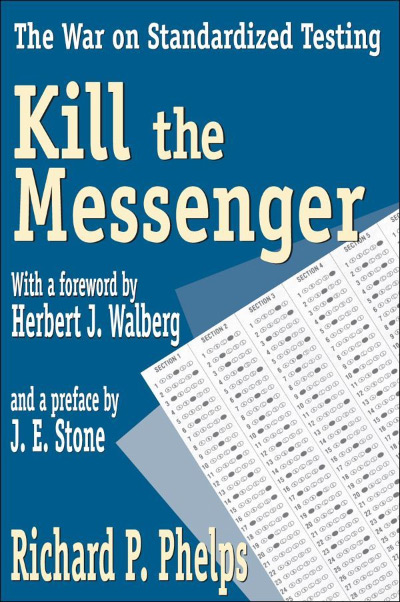 Kill the Messenger: The War on Standardized Testing, by Richard Phelps. Transaction, 2003.
Kill the Messenger: The War on Standardized Testing, by Richard Phelps. Transaction, 2003.
Herbert J. Walberg writes in the preface: “Ricard Phelps has written a scholarly book that legislators, citizens, parents, scholars, and educators should read. The book is not only scholarly but is entertainingly written. It informs us about the one-sided ‘testing wars’ that have gone on for [decades]. ...
“Taxpayers who pay the school bills have a right to know the quality of results their hard-earned money buys. Legislators and school boards cannot be stewards of children’s academic progress without objective information on what students learn. ... [Achievement tests] provide information [to educators] on what students have and have not learned which should guide their daily lessons and help them to revise curricula and methods of instruction. ... Parents ... can be helpful in their children’s learning when they are well-informed about their progress, strengths, and weaknesses.”
Publisher’s promotional material: “Phelps points out that much research conducted by education insiders on the topic is based on ideological preference or profound self-interest. It is not surprising that they arrive at emphatically anti-testing conclusions. He notes that external and high stakes testing in particular attracts a cornucopia of invective. Much, if not most, of this hostile research is passed on to the public by journalists as if it were neutral, objective, and independent. Kill the Messenger describes the current debate, the players, their interests, and their positions. It explains and refutes many of the common criticisms of testing. It describes testing opponents’ strategies. ... It acknowledges testing’s limitations, and suggests how it can be improved. It defends testing by comparing it with its alternatives. And finally, it outlines the consequences of losing the war on standardized testing.”
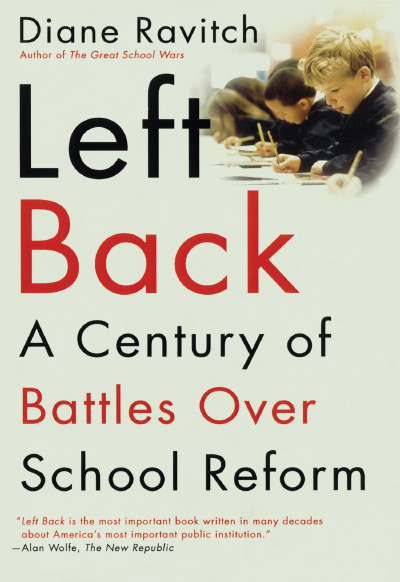 Left Back: A Century of Failed School Reforms, by Diane Ravitch. Simon & Schuster, 2000.
Left Back: A Century of Failed School Reforms, by Diane Ravitch. Simon & Schuster, 2000.
This book is a history of Progressive Education in the United States, pointing out its deleterious effects. Ravitch describes Progressive Educators as holding that “the methods and ends of education could be derived from the innate needs and nature of the child—the basis of the child-centered movement; ... the methods and ends of education could be determined by assessing the needs of society and then fitting children for their role in society—the basis of the social efficiency movement; and ... the methods and ends of education could be changed in ways that would reform society—the basis of the social reconstruction movement.”
“Liberal Ideology and the Quest for Orderly Change,” by Clarence J. Karier. History of Education Quarterly, vol. 12 (Spring 1972), 57-80. Reprinted in Roots of Crisis: Essays in Twentieth Century Education, ed. by Clarence J. Karier, Joel Spring, and Paul C. Violas. Rand McNally, 1973, pp. 84-107.
Karier writes, “Classical liberalism, with its philosophical justification of a competitive economy, private property, individualism, and freedom from state interference, gave way to the new liberalism that espoused a controlled economy, state planning, group thought, and managed change. ...
“[John Dewey’s concerns were] those of a management-welfare state socialist. ... Dewey’s inadequate conception of political democracy led him to look at a totalitarian society [Communist Russia] organizing its population educationally to participate in the bureaucratic system at various institutional levels and call that society democratic. ... Dewey had long ago rejected the classical conception of individualism and its political corollary of a free marketplace of conflicting ideas. ...
“Dewey’s unbounded faith in science and technology led him to call for a new man. Such a man must work well within the corporate [state] system where, almost in Orwellian fashion, positive freedom would mean control. ... The solution to social conflict, for Dewey, remained the intelligent use of education for social control. The direction such control should take, he believed, could be determined by scientific method. ... Dewey’s new liberal ideology ... remained fairly constant from his Chicago Laboratory School until late in life, when he favorably reviewed Karl Mannheim’s book, Man and Society (1940). In which Mannheim called for elites to plan the new social order.”
In a 1979 follow-up paper, Karier writes, “In retrospect, Randolph Bourne seems to have been correct when he suggested that the practical consequences of Dewey’s philosophy would result in the creation of a cadre of ‘young liberals, who would direct their course by an opportunistic programme of state-socialism at home and a league of benevolently-imperialistic nations abroad.’”
“Liberty and Education: John Stuart Mill’s Dilemma,” by Edwin G. West. Philosophy, the Journal of the Royal Institute of Philosophy, April 1965. Download PDF
West writes, “After much serious thought J. S. Mill argued for very special treatment for education and accordingly made the following proposals: first, education was to be made compulsory by law; secondly, the State was to see that this law was respected not by providing state schools (except in exceptional circumstances) but by instituting a system of examinations. Should a child fail to attain a certain minimum standard then his parents were to be taxed and the proceeds devoted to his continued education. Cases of exceptional poverty were to be met by special financial dispensations from the state earmarked for the payment of subsidies or fees.”
“The Long Reach of Teachers Unions,” by Mike Antonucci. Education Next, vol. 10, no. 4 (Fall 2010).
Antonucci writes, “The extent of teachers’ union influence over education policy is widely known. Education reformers have long recognized the clout of NEA and AFT when it comes to contentious issues like performance pay, charter schools, and testing. School administrators know of their power to affect education budget and personnel decisions. Politicians are aware of their unmatched ability to turn out volunteers for the dog work of campaigning—phone banks, precinct walks, and rallies. Reporters write about all of this.
“Yet teachers unions as a massive general political force is an untold story. Rarely discussed is union influence over state and federal elections and over domestic policy, from fundamental issues such as taxation and health care to more esoteric ones, such as gay marriage and redistricting. It’s astonishing that a single organization can spend more than $56.3 million in an election cycle and still fly under the radar.”
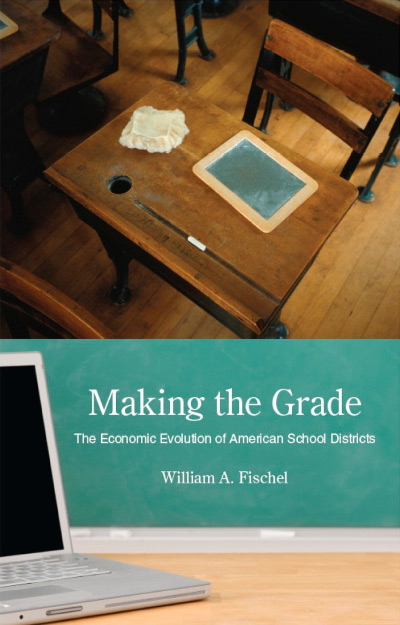 Making the Grade: The Economic Evolution of American School Districts, by William A. Fischel. University of Chicago Press, 2009.
Making the Grade: The Economic Evolution of American School Districts, by William A. Fischel. University of Chicago Press, 2009.
Fischel applies analysis based on competitive federalism and Tiebout competition to America’s system of local school districts. He writes, “A decentralized system of governance ... offers more choices to ‘vote with your feet’ among school districts ... and also induces school authorities to pay closer attention to effective education.”
Among other things, Fischel looks at why the school year is from September to June. He suggests the standard school year was adopted because it facilitated labor mobility. He looks also at why voters reject opportunity scholarships (vouchers). He suggests that voters (particularly in suburbia) reject them because they fear that vouchers will dismantle community-based social capital that’s embedded in public-school systems. “Local public schools provide localized social capital—the list of people you know locally—for the parents of school children.” He suggests that charter schools in urban areas can be the kind of locale of social capital that regular public schools are in suburbia.
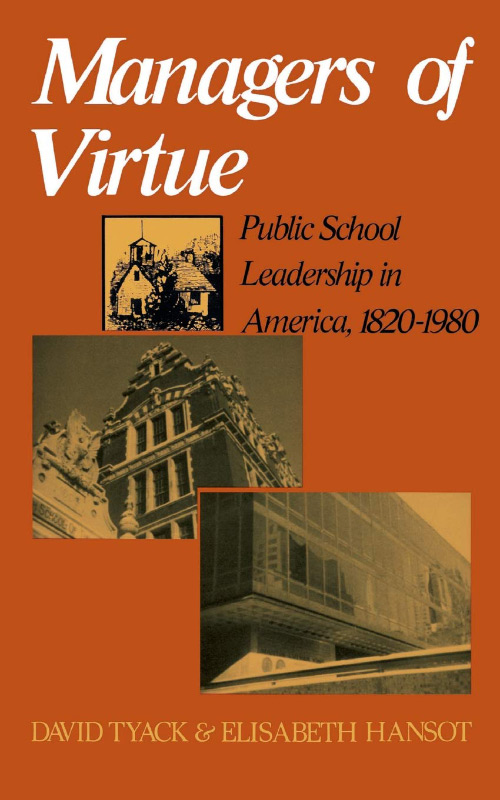 Managers of Virtue: Public School Leadership in America, 1820–1980, by David Tyack and Elisabeth Hansot. Basic Books, 1986.
Managers of Virtue: Public School Leadership in America, 1820–1980, by David Tyack and Elisabeth Hansot. Basic Books, 1986.
Hugh Davis Graham writes, “[E]ducation’s twentieth-century social engineers ... constituted the familiar ‘educational trust’ of the administrative progressives, whose modern managerial model would re-channel and constrain public participation, and would replace elected ward and lay leadership with administrative and business elites to preside over a relatively closed and nonpolitical system. Theirs was the gospel of scientific efficiency [and] of consolidation. ... Their bureaucratic, professional, and professedly nonpolitical world was ... concerned with training and staffing the human machinery of industrial expansion, and with nurturing the social control necessary to sustain it.”
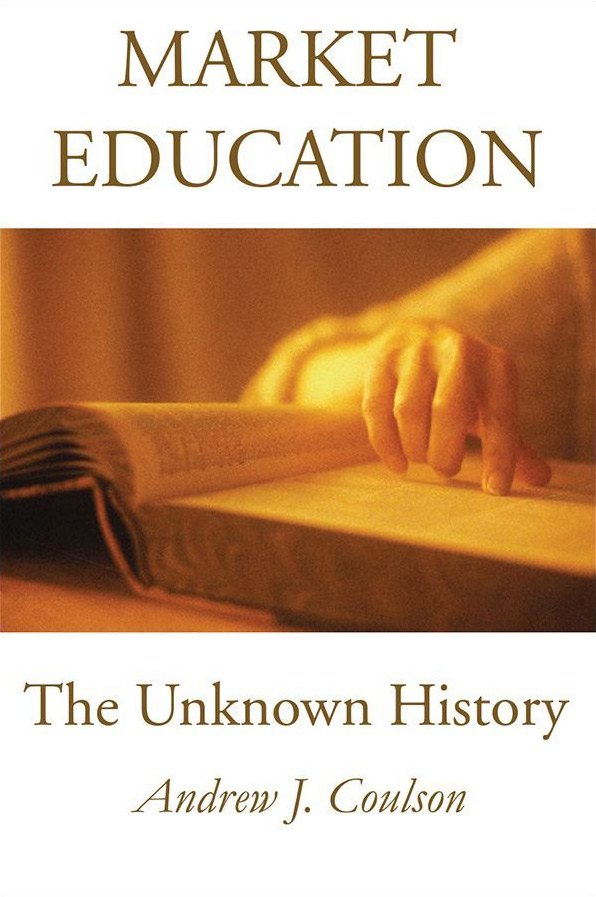 Market Education: The Unknown History, by Andrew J. Coulson. Transaction Publishers for the Social Philosophy and Policy Center, 1999.
Market Education: The Unknown History, by Andrew J. Coulson. Transaction Publishers for the Social Philosophy and Policy Center, 1999.
George C. Leef writes, “Coulson’s historical overview of educational history is extremely beneficial. Government education is so widely assumed to be the only possibility that many will be surprised to learn there have been places and times when government kept out entirely. The author’s contrast between Athens and Sparta in ancient Greece is illustrative. In Athens, Coulson writes, “with the exception of two years of military training, the state played no role in schooling. ... Parents paid monthly tuition for the education of their children at whichever of the numerous private schools they preferred. ...
“‘Athens was the intellectual center of the Mediterranean, a wellspring of genius in science, mathematics, philosophy, literature, and more. All those brilliant thinkers working in a culture that esteemed learning—and not a government school to be found! In contrast, Sparta established a government education monopoly to ensure the preservation of the collectivist/militarist philosophy of Lycurgus and later rulers. ... Intellectual and artistic achievements of the Spartans? Virtually none,’ Coulson remarks, ‘apart from being a beacon to those advocating totalitarian systems of education.’
“The author’s investigation into the history of education, both market-driven and state-dominated, proceeds on through Rome, the Middle Ages, the Islamic world (which initially followed the Athenian approach, with similarly magnificent results), and eventually to the last several centuries in England, France, Germany, and the United States. ... The largest part of the book is Coulson’s examination of the American educational experience. ...”
“Master’s of None,” by Grace Gedye. Washington Monthly, January-February-March 2020.
On the “master’s bump” in teachers’ salaries. The magazine’s subheadline summarizes the article: “Teachers across the country earn grad degrees to get raises. Turns out those degrees don’t improve student learning—they just fatten universities’ bottom lines.”
Minority Students in Catholic High Schools, by Andrew W. Greeley. Transaction Books, 1982.
Anthony Bryk, Valerie E. Lee, and Peter B. Holland write that Greeley argues that “not only was the achievement of minority students in Catholic schools greater than that of minority students in public schools, but that those differences were greatest for the most disadvantaged youth—youth from poor families, those whose parents had a limited education, and those enrolled in nonacademic curricular programs.”
The Mirage: Confronting the Hard Truth about Our Quest for Teacher Development, The New Teacher Project, 2015. Download PDF
The school districts that participated in this study spent an average of $18,000 per teacher annually on professional development (training of teachers who are already teaching). The New Teacher Project estimated that the 50 largest school districts spend an estimated $8 billion on teacher development annually. The 10,000 teachers surveyed were in training an average of 19 school days a year, or almost 10 percent of a typical school year. The study found that no specific type or amount of professional development helped teachers improve. Education economist Eric Hanushek says, “The bottom line is, they’re spending a lot of money on [professional development], and it’s such an appealing idea—take your existing teachers and just make them better, and everybody is better off. But this report finds that, on average, it doesn’t do much.”
“‘Misinformed’ About Common Core, Indeed,” by Neal McCluskey. RealClearPolitics, September 13, 2015.
McCluskey writes about how the federal government under the Obama administration pushed the states into adhering to the Common Core national curriculum-content standards.
“A Modest Proposal for Saving Our Schools,” by Tom McClintock. Voice of San Diego, June 14, 2005.
In 2005, then California state senator (later Congressman) Tom McClintock detailed what you could buy with $6,937 per K-12 student: luxury office suites, college professors (at the associate professor level), private gym memberships. McClintock writes, “The school I have just described is the school we’re paying for. Maybe it’s time to ask why it’s not the school we’re getting.”
“Money and School Performance: Lessons from the Kansas City Desegregation Experiment,” by Paul Ciotti, Cato Institute Policy Analysis, no. 298, March 16, 1998. Download PDF
Ciotti writes, “For decades, critics of the public schools have been saying, ‘You can’t solve educational problems by throwing money at them.’ The education establishment and its supporters have replied, ‘No one’s ever tried.’ In Kansas City they did try. To improve the education of black students and encourage desegregation, a federal judge invited the Kansas City, Missouri, School District to come up with a cost‐is‐no‐object educational plan and ordered local and state taxpayers to find the money to pay for it.
“Kansas City spent as much as $11,700 per pupil—more money per pupil, on a cost-of-living-adjusted basis, than any other of the 280 largest districts in the country. The money bought higher teachers’ salaries, 15 new schools, and such amenities as an Olympic‐sized swimming pool with an underwater viewing room, television and animation studios, a robotics lab, a 25‐acre wildlife sanctuary, a zoo, a model United Nations with simultaneous translation capability, and field trips to Mexico and Senegal. The student‐teacher ratio was 12 or 13 to 1, the lowest of any major school district in the country. The results were dismal. Test scores did not rise, [and] the black‐white gap did not diminish.”
The Moral and Religious Roots of Social and Emotional Learning, by Jay P. Greene. American Enterprise Institute, 2019. Download PDF
As moral education and character education have declined, educational policy makers have sought to fill the void with social and emotional learning, which is a technocratic substitute. The proponents of SEL seek to appeal to the educational world’s love of scientific-sounding rhetoric by organizing SEL in terms of seemingly nonmoral concepts and terms from the discipline of psychology. Proponents then seek to evaluate students and push them toward centrally-set goals. But the concepts involved are too vague and malleable to lend themselves to scientific measurement.
The Myth of the Common School, by Charles L. Glenn. University of Massachusetts Press, 1988. Download PDF of Ph.D thesis
Author’s abstract of the original Ph.D. thesis: “A study of the history of the idea of State-sponsored popular education to mold common loyalties and values in the interest of national unity. The study finds that this idea has implied rivalry with competing sources of meaning, including traditional religion. This rivalry has taken the form not only of excluding ‘sectarian’ teaching from the common school, but also of seeking to provide its equivalent: a ‘common faith.’ In so doing, it has led repeatedly to conflict with parents who do not accept the values and beliefs inculcated by the State and its educationists. The first attempt, by the French Jacobins in 1792, to implement this ‘common school agenda’ in an antireligious form was a failure because of the resistance of parents, but their Dutch allies were more successful implementing common schools saturated with lowest-common-denominator religious and moral teaching. It was Dutch ‘common school religion’ that inspired French and American reformers in the 1830’s in the creation of State-sponsored common schools. Implementation of the common school program in Massachusetts encountered resistance from orthodox Protestants as well as Catholics to what they rightly perceived as its religious content, but Protestant leadership closed ranks around the common school when faced by the threat of cultural diversity as a result of Catholic immigration. ... The continuing conflict over popular education raises troubling questions in a democracy. How can the pluralism that we claim to value, the liberty that we prize, be reconciled with a ‘State pedagogy’ designed to serve State purposes.”
Nationally Normed Elementary Achievement Testing in America’s Public Schools, by John Jacob Cannell. Friends for Education, 1987.
Richard Phelps writes, “Cannell ... had been surprised that West Virginia students kept scoring ‘above the national average’ on a national norm-referenced standardized test (NRT), given the state’s low relative standing on other measures of academic performance. He surveyed the situation in other states and with other NRTs and discovered that the students in every state were ‘above the national average,’ on elementary achievement tests, according to their norm-referenced test scores. The phenomenon was dubbed the ‘Lake Wobegon Effect,’ in tribute to the mythical radio comedy community of Lake Wobegon, where ‘all the children are above average.’”
“The Next Step in School Choice,” by Jason Bedrick and Lindsey M. Burke. National Affairs, Winter 2015: 138-151. Download PDF
The authors write, “Though Education Savings Accounts are still taxpayer funded, the way they are structured makes for a dynamic closer to the one involved in spending your own money on your own children: Parents still insist on the best quality education but have more incentive to find a bargain. ESAs are not the equivalent of cash because the funds are restricted to approved categories of educational expenses, but they do provide families with much greater flexibility in how to spend (or save) the funds than vouchers do. ...
“Because families can spend ESA funds at multiple providers and can save unspent funds for later, ESAs incentivize families to economize and maximize the value of each dollar spent, in a manner similar to the way they would spend their own money. ESAs also create incentives for education providers to unbundle services and products to better meet students’ individual learning needs.”
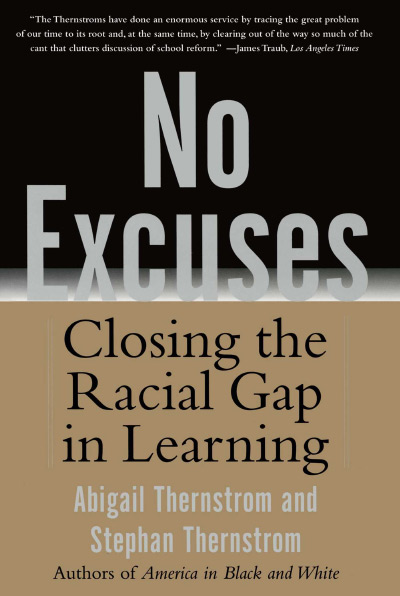 No Excuses: Closing the Racial Gap in Learning, by Abigail and Stephan Thernstrom. Simon & Schuster, 2003.
No Excuses: Closing the Racial Gap in Learning, by Abigail and Stephan Thernstrom. Simon & Schuster, 2003.
Jason L. Riley writes that the Thernstroms argue that “the racial achievement gap in the classroom has less to do with education spending and ‘racist’ tests and more to do with cultural attitudes toward education and the lack of school choice.” Stuart Taylor, Jr., writes that the book makes a strong case “that the main remedies traditionally prescribed by the major civil-rights and education groups for the academic troubles of black students either have failed or won’t work. More racial integration, more money, smaller class sizes, assigning the best teachers to the worst schools—none of these promises much progress, if any, in closing the academic gap.” Named by the Los Angeles Times as one of the best books of 2003.
“No Exit, No Voice: The Design of Common Core,” by Williamson M. Evers. Heritage Foundation, 2015. Download PDF
Abstract: “Albert Hirschman’s Exit, Voice, and Loyalty provides valuable conceptual tools for analyzing the design of the Common Core national curriculum content standards. Hirschman points out that the two basic responses to deteriorating services are ‘exit’ and ‘voice,’ where exit means turning to a different provider or leaving the territory, while voice means political participation. By trying to block exit and deny voice, the designers of Common Core and the policymakers who put it in place have caused blowback: A large parent-, teacher-, and community-based movement has arisen, as organized parents are—in what Hirschman called an ‘intimate fusion of exit and voice’—pressing for repeal of Common Core and the national tests that support it.”
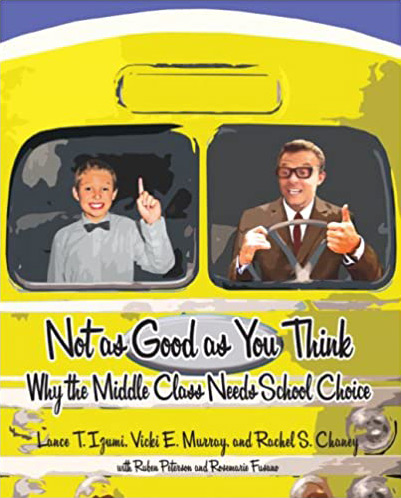 Not as Good as You Think: Why the Middle Class Needs School Choice, by Lance T. Izumi, Vicki E. Murray and Rachel S. Chaney. Pacific Research Institute, 2007.
Not as Good as You Think: Why the Middle Class Needs School Choice, by Lance T. Izumi, Vicki E. Murray and Rachel S. Chaney. Pacific Research Institute, 2007.
Despite the widespread perception that public neighborhood schools in affluent areas are high performing, the authors of Not as Good as You Think show that even they are under-preparing their students. Eugene Hickok, U.S. Deputy Secretary of Education during President George W. Bush’s first term, writes, “This book confronts the depth of the challenge confronting public education, in California and across the country, and makes it more difficult for the apologists of the status quo to continue to defend mediocrity. It helps sow the seeds of what can become a much-needed American education revolution.”
“Not Just the Problem of Other People’s Children: U.S. Student Performance in Global Perspective,” by Eric A. Hanushek, Paul E. Peterson, and Ludger Wößmann. Program on Education Policy and Governance, Harvard University and Education Next, 2014. Download PDF
Education Next writes, A ... study from researchers Eric Hanushek (Stanford University), Paul E. Peterson (Harvard University), and Ludger Wößmann (University of Munich) finds that U.S. schools do as badly at teaching those from better-educated families as they do at teaching those from less well-educated families.
Ashley Berner looks at the international-comparison findings from this study in terms of plural school systems versus uniform systems. She writes, “[T]his team used parental education as a proxy for general socioeconomic standing. They then compared students from low-, middle-, and upper-class standing in different countries to one another. The results show that plural systems often produce top results. On math scores, for instance, seven of the 10 countries with the highest scores among students from the most disadvantaged homes have plural systems. Seven of the 10 countries with the highest scores among students whose parents have had a moderate level of education have plural systems. Seven of the 10 countries with the highest scores among students from educationally elite homes have plural systems. This analysis also indicates that some countries with uniform school systems, such as Japan and Korea, score at the top of the PISA charts and hold their advantage across all socioeconomic levels. We can draw a modest conclusion from this study: many countries with plural education systems are academically successful, not only for the wealthiest students but also for the most disadvantaged.”
The Not-So-Great Society, ed. by Lindsey M. Burke and Jonathan Butcher. Heritage Foundation, 2019.
A collection of essays covering educational policies which continue to blight schools today. Rep. Chip Roy (R-TX) writes, “Just because we should do something—whether it’s to educate future Americans or care for the needy—doesn’t mean the federal government is either empowered or best suited to do it. Indeed, we put a man on the moon 10 years before the Department of Education was created. I applaud The Heritage Foundation for highlighting the false promises of big government and re-focusing attention on unleashing the imagination of Americans by relying on achievement, civil society, and local solutions to tackle our challenges.”
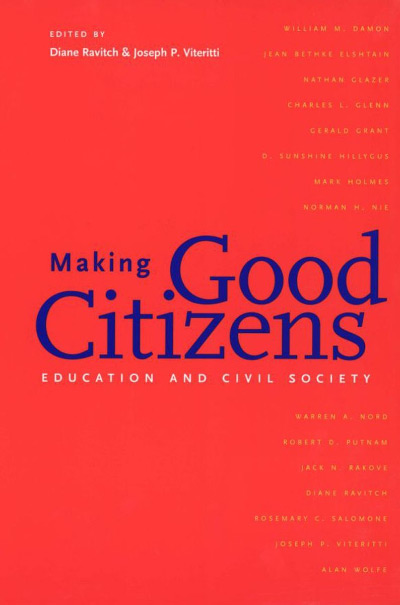 “Once More into the Breach: Reflections on Jefferson, Madison, and the Religion Problem,” by Jack N. Rakove. In Making Good Citizens: Education and Civil Society. ed. by Diane Ravitch and Joseph P. Viteritti. Yale University Press, 2001, pp. 233-262.
“Once More into the Breach: Reflections on Jefferson, Madison, and the Religion Problem,” by Jack N. Rakove. In Making Good Citizens: Education and Civil Society. ed. by Diane Ravitch and Joseph P. Viteritti. Yale University Press, 2001, pp. 233-262.
Rakove writes, “Arguably, ... elements in their political and social theories might incline [Jefferson and Madison]—could they be transported to our own time—to modify their aversion to [state aid to religious institutions] in the interest of securing other legitimate ends [through school choice and vouchers]. Jefferson, after all, was no friend to the capacity of the state to exercise monopolistic powers or grant monopolistic privileges; and many advocates of school choice can plausibly argue that the edifice of public education, resting as it does on the coercive authority of the bureaucratic state and the support of politically powerful teachers' unions, depends on the enjoyment of a quasi-monopolistic privilege.
“Or again, Madison’s distinctive commitment to the protection of minority rights—especially the rights of religious dissenters—might incline him to accept the value of policies that would enable citizens possessing deep religious convictions to escape the tyranny of a secular humanism that is often perceived (or at least alleged) to be hostile to such beliefs.”
"Once More into the Breach: Reflections on Jefferson, Madison, and the Religion Problem," by Jack N. Rakove. In Making Good Citizens: Education and Civil Society, ed. by Diane Ravitch and Joseph P. Viteritti. Yale University Press, 2001: 233-262.
Rakove writes, "Arguably, ... elements in their political and social theories might incline [Jefferson and Madison] -- could they be transported to our own time -- to modify their aversion to [state aid to religious institutions] in the interest of securing other legitimate ends [through school choice and vouchers]. Jefferson, after all, was no friend to the capacity of the state to exercise monopolistic powers or grant monopolistic privileges; and many advocates of school choice can plausibly argue that the edifice of public education, resting as it does on the coercive authority of the bureaucratic state and the support of politically powerful teachers' unions, depends on the enjoyment of a quasi-monopolistic privilege.
"Or again, Madison's distinctive commitment to the protection of minority rights -- especially the rights of religious dissenters -- might incline him to accept the value of policies that would enable citizens possessing deep religious convictions to escape the tyranny of a secular humanism that is often perceived (or at least alleged) to be hostile to such beliefs."
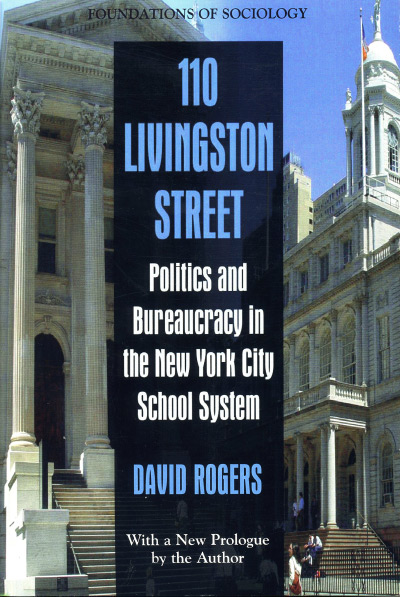 110 Livingston Street: Politics and Bureaucracy in the New York City School System, by David Rogers. Random House, 1968.
110 Livingston Street: Politics and Bureaucracy in the New York City School System, by David Rogers. Random House, 1968.
This book is important not so much for the solution it proposes (decentralization and community control) as for its analysis of the public school bureaucracy. Livingston writes, “[The public school system in New York City has] such characteristics as: (1) overcentralization, the development of many levels of in the chain of command, and an upward orientation of anxious subordinates; (2) vertical and horizontal fragmentation; ... (3) the consequent development of [aggrandizing tendencies] within particular units, reflected in actions to protect and expand their power; (4) the exercise of strong pressure from peers within units to conform to their informal codes, geared toward political protection and expansion; ... (5) compulsive rule following and rule enforcing; (6) the rebellion of lower-level supervisors against headquarters directives, alternating at times with overconformity, as they develop concerns about ratings and promotions; (7) increasing isolation from clients, as internal politics and personal career interests override interests in serving various publics; and the tendency to make decisions in committees, making it difficult to pinpoint responsibility and authority. ...”
Out-of-Field Teaching and the Limits of Teacher Policy, by Richard Ingersoll. Center for the Study of Teaching and Policy, University of Washington; and Consortium for Policy Research in Education, University of Pennsylvania, 2003. Download PDF
From the abstract: “This report focuses on the problem of underqualified teachers in the core academic fields at the 7-12th grade level. Using data from the nationally representative Schools and Staffing Survey, conducted by the National Center for Education Statistics, this analysis examined how many classes are not staffed by minimally qualified teachers. ... The data show that while almost all teachers hold at least basic qualifications, there are high levels of out-of-field teaching—teachers assigned to teach subjects that do not match their training or education.” ERIC writes: “The data show [that] the source of out-of-field teaching lies not in the amount of education teachers have, but in a lack of fit between teachers’ fields of training and their teaching assignments. Hence, reforms designed to upgrade the training of teachers will not eliminate out-of-field teaching, if large numbers of such teachers continue to be misassigned by their principals.”
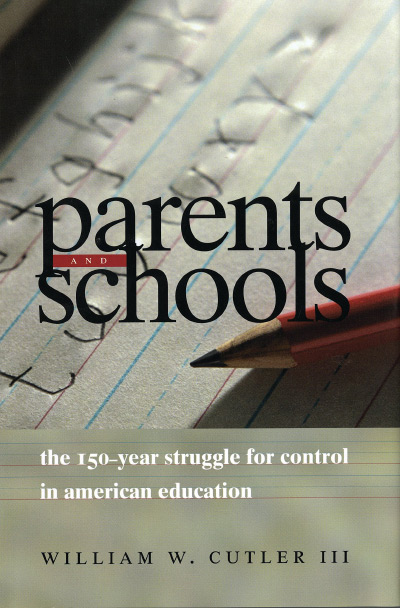 Parents and Schools: The 150-Year Struggle for Control in American Education, by William W. Cutler III. University of Chicago Press, 2000.
Parents and Schools: The 150-Year Struggle for Control in American Education, by William W. Cutler III. University of Chicago Press, 2000.
Scholarly account of how within Parent-Teacher Associations, parents are controlled by teachers.
“The Political Economy of the Decline of American Public Education,” by Sam Peltzman. Journal of Law and Economics, vol. 36, no. 1, pt. 2 (April 1993): 331-370. Download PDF
Includes discussion of the effect of teacher unionization on student performance and the effect of the shifting of school finance from local property taxes to state budgets. Peltzman writes, “The overwhelming majority of American elementary and secondary schools are political creatures. They are publicly owned, operated, directed, and funded. I want to see if the political character of the [milieu] within which schools operate has something to do with the way they perform.”
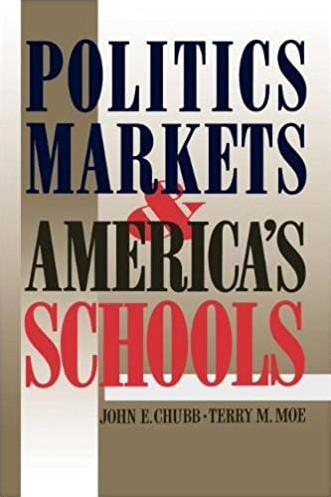 Politics, Markets, and America’s Schools, by John E. Chubb and Terry M. Moe. Brookings Institution Press, 1990.
Politics, Markets, and America’s Schools, by John E. Chubb and Terry M. Moe. Brookings Institution Press, 1990.
The classic account of why opportunity scholarships (school vouchers) would be a panacea, fixing all the major ills of K-12 education in America. Chubb and Moe write that the opportunity scholarship “is a self-contained reform [that] has the capacity all by itself to bring about the kind of transformation that, for years, reformers have been seeking to engineer in myriad other ways.”
Preserving a Critical National Asset: America’s Disadvantaged Students and the Crisis in Faith-based Urban Schools. U.S. Department of Education, 2008. Download PDF
Excerpt: “Faith-based schools appeal to millions of American families for numerous reasons. For example, such schools enable parents to pass down religious and cultural traditions important to their families and communities. Some families, concerned about the gradual coarsening of our culture, gravitate to the disciplined, ordered environment often associated with faith-based schools. And faith-based schools can contribute to moral development—an important foundation, in the minds of many families, for academic development. ...
“Our nation has an interest in supporting educational diversity so families can make school choices that align with their notions of the best interests of their children. This has long been an agreed-upon premise of American life. In 1925, the Supreme Court famously wrote of ‘the liberty of parents and guardians to direct the upbringing and education of children under their control.’...
“[A]re faith-based urban schools providing a high-quality education to America’s children, in particular to our most disadvantaged boys and girls? Research powerfully indicates that they are.”
“The Productivity Collapse in Schools,” by Eric A. Hanushek. In Developments in School Finance, 1996, ed. by William J. Fowler, National Center for Educational Statistics, U.S. Department of Education, 1997, pp. 183-195. Download PDF
Hanushek writes, “My explanation [for the productivity collapse (rapidly increased spending without notable improvement in student achievement)] is [simple and straightforward]. The structure of schools does not provide incentives to improve student performance or to conserve on costs. Therefore, it is not particularly surprising that these do not happen.”
“Progressive Social Philosophy: Charles Horton Cooley and Edward Asworth Ross,” by Paul C. Violas. In Roots of Crisis: Essays in Twentieth Century Education, ed. by Clarence J. Karier, Joel Spring, and Paul C. Violas. Rand McNally, 1973, pp. 40-65.
Violas writes on progressives as proponents of the collectivist “corporate state” and of centrally-guided workforce planning, “Cooley’s and Ross’s vision of a good society was that of a rationally organized corporate state. Existential autonomy of the individual was considered dysfunctional. Their good society was grounded in the belief that man received is self, identity, and humanity from the social group. ... Social problems ... could be intelligently attacked only if an expert elite was allowed to make correct social decisions. ...
Scientific administration of occupations and social roles, Ross and Cooley insisted, could not be left to individual caprice. ... Cooley argued that ‘an all wise despot would undoubtedly be the most efficient’ ... Although he rejected this ideal solution as unrealistic for American social conditions, it did contain the basic sentiment embodied in his realistic proposals. ... Progressives considered the public school the crucial institution in which to conduct society’s scientific administration of personnel.
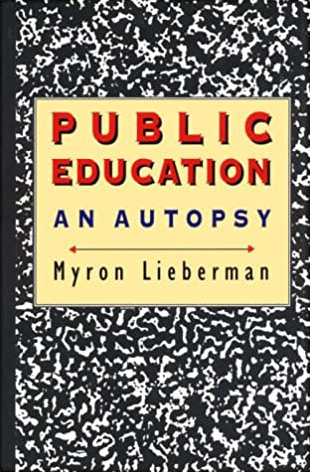 Public Education: An Autopsy, by Myron Lieberman. Harvard University Press, 1993. Download PDF
Public Education: An Autopsy, by Myron Lieberman. Harvard University Press, 1993. Download PDF
ERIC: “This book argues that public education no longer fosters in students basic skills, scientific and cultural literacy, civic virtues, and desirable habits/attitudes toward society and its institutions. The book asserts that government provision of goods and services is usually less effective and efficient than provision through a market system. It advances a market approach to education that includes a three-sector industry comprised of public schools, nonprofit private schools, and schools for profit. Following the introduction, chapter 2 describes the future context of public education, shaped by cultural and demographic changes. Conflicts of interest between producers and consumers in public education and their resolution in the private sector are discussed in the third chapter. A critique of the public-education information system is provided in chapter 4. The fifth chapter advances reasons why the market system provides a superior educational information system. The next seven chapters explore the real costs of public education, educational outcomes as an efficiency issue, the educational consequences of racial conflict, a reconsideration of the equality of educational opportunity, the impact of higher education on the public schools, educational research and development, and the educational agenda and its problems.”
The Public School Monopoly: A Critical Analysis of Education and the State in American Society, ed. by Robert B. Everhart. Pacific Research Institute for Public Policy, 2002.
ERIC: “Fourteen essays consider relationships among schooling, education, and the state; alternatives to existing systems; and educating minorities and the disadvantaged: (1) ‘Growing Up Blighted: Reflections on the “Secret Power” in the American Experience’ (C. Burgess); (2) ‘The Evolving Political Structure of American Schooling’ (J. Spring); (3) ‘Nineteenth-Century Opponents of State Education: Prophets of Modern Revisionism’ (G. H. Smith); (4) ‘Schooling for Work and Working at School: Perspectives on Immigrant and Working-Class Education in Urban America, 1880-1920’ (C. H. Edson); (5) ‘Critical Literacy: A Conception of Education as a Moral Right and a Social Ideal’ (M. S. Katz); (6) ‘The Manipulation of Consciousness: A First Amendment Critique of Schooling’ (S. Arons and C. Lawrence III); (7) ‘A Comparative and International Perspective on the Prospects for Family and Community Control of Schooling’ (T. J. La Belle); (8) ‘Changing Political Patterns and Governmental Regulations’ (L. Iannaccone); (9) ‘Institutional Parameters and the Purposes of Schooling: State Regulation of Educational Innovation’ (R. B. Everhart); (10) ‘The Prospects for Education Vouchers: An Economic Analysis’ (E. G. West); (11) ‘Disturbing Evidence about the One Best System’ (D. A. Erickson); (12) ‘The Impact of Taxation Policy on Public and Private Schools’ (T. W. Vitullo-Martin); (13) ‘Educational Tax Credits’ (R. A. Freeman); and (14) ‘Education and Cultural Reproduction: A Critical Reassessment of Programs for Choice’ (M. W. Apple). A conclusion by R. B. Everhart summarizes the relationships between education and the state.”
The Quick Fix: Why Fad Psychology Can’t Cure Our Social Ills, by Jesse Singal. Farrar, Straus and Giroux, 2021.
Singal covers a multitude of sins, including: How fostering artificial self-esteem in children, somehow nurturing “grit” (perseverance) in students, and using a deeply-flawed psych test (the Implicit Association Test) to supposedly detect racist proclivities have damaged a multitude of people as well as the educational process itself.
Really Good Schools: Global Lessons for High-Caliber, Low Cost Education, by James Tooley. Independent Institute, 2021.
Tooley says that his “main objection to charter schools and school vouchers [is that] both are still part of a ‘supplicant model’ that assumes government education. We’re allowed to approach the government as supplicants and ask, beg even, to be allowed some small-scale baby steps that embody some aspects of educational independence.” Tooly argues that a “grassroots revolution of low-cost private schools” can restore the educational independence that parents need.
“Refining or Retreating? High-Stakes Accountability in the States,” by Frederick M. Hess. In No Child Left Behind?: The Politics and Practice of School Accountability, ed. by Paul E. Peterson. Brookings Institution Press, 2003, pp. 55-79. Download PDF
From the author’s abstract: This paper examines ways in which context influences the implementation of high-stakes accountability systems. The trajectory of implementation efforts has followed a familiar course, with the emergence of scattered opposition prompting officials to ‘refine’ testing systems in predictable ways. These efforts placate critics while softening the [bite] of accountability. Whether these revisions eviscerate the larger system depends largely on the balance of political pressure. The paper addresses such questions as ‘Why do high-stakes accountability systems launched to widespread acclaim meet growing pockets of resistance even as student performance soars? Why are accountability provisions softened or made more flexible in predictable ways? and What are the implications of these issues for the promise of accountability-driven reform?’"
“Revitalizing Teacher Education by Revisiting Our Assumptions about Teaching,” by Frederick M. Hess, Journal of Teacher Education, vol. 60, no. 5 (2009).
Hess writes: “Even in the most innovative schools and districts, teaching assignments bundle together the roles of content deliverer, curriculum designer, diagnostician, disciplinarian, discussion leader, empathizer, secretary, and attendant–and ask teachers to fulfill these roles for a variety of students. Efforts to import specialization into schooling have often been half-hearted, with special education or English-language learning ‘specialists’ spending 15 hours a week or more on mandated paperwork and assuming instructional duties that entail serving some students for whom their specialty is irrelevant. Similarly, the growing ranks of instructional aides have not been used to focus, narrow, or otherwise really rearrange the work that teachers perform.”
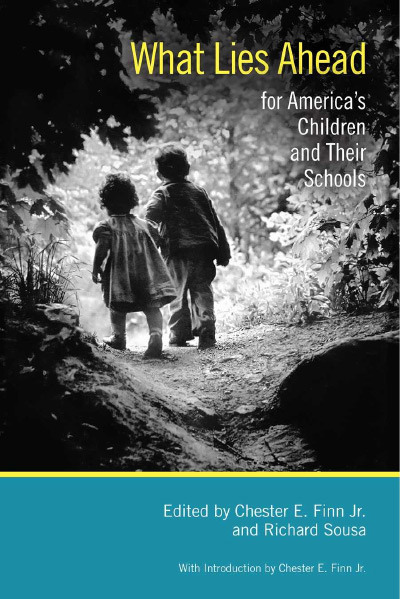 “Rewarding and Employing Teachers Based on Their Value-Added,” by Caroline Hoxby. In What Lies Ahead for America’s Children and Their Schools, ed. by Chester E. Finn Jr. and Richard Sousa. Hoover Institution Press, 2014.
“Rewarding and Employing Teachers Based on Their Value-Added,” by Caroline Hoxby. In What Lies Ahead for America’s Children and Their Schools, ed. by Chester E. Finn Jr. and Richard Sousa. Hoover Institution Press, 2014.
Hoxby writes, “A teacher who is in the top 10 percent of the current distribution of value-added raises student achievement by several times what a teacher in the bottom 10 percent does. If all US teachers had value-added equal to what the current top 10 percent has, the average American student would achieve at the level of students whose parents have incomes in the top 10 percent of the family income distribution. This is approximately equivalent to the level at which the average student in Singapore achieves. Even after a single year of teaching, we can predict a teacher’s value-added sufficiently well that the retention decision can be made at that point. Two years of teaching experience adds information, but subsequent years of teaching add little to our predictions.
“After the first few years of teaching (during which most teachers’ value-added rises, apparently through on-the-job learning), a teacher’s value-added remains fairly stable. ... Teachers with master’s degrees do not have systematically higher value-added. If anything, the evidence suggests that master’s degrees are associated with lower value-added. There are almost no credentials that predict a teacher’s value-added, with the exception that individuals who attended a more selective college tend to have higher value-added. This is presumably due not only to their higher aptitude and better education but also to the fact that selective colleges admit students in a fairly holistic way that rewards leadership, motivation, and similar traits.”
“The Role of Government in Education,” by Milton Friedman. In Economics and the Public Interest, ed. by Robert A. Solo. Rutgers University Press, 1955. Reprinted in Capitalism and Freedom. University of Chicago Press, 1962. Download PDF
James Tooley writes, “Friedman’s proposed voucher system creates many freedoms. Schools should be allowed to be for-profit or nonprofit; clearly there should be no objection to for-profit schools, as the profit motive is a major source of incentive for innovation and growth. Parents should have no restriction on their choice of school. They should be allowed to supplement the amount given to them by government—there should be no egalitarian restrictions against parents “topping up” vouchers to increase the funding available to expand educational innovation even further (for the same reason given below concerning universality).
“The voucher system should also be universal, rather than aimed at only specifically targeted groups, such as the poor. In part, this is because compulsory schooling is required to bring about the desired neighborhood effect of education for democracy; compulsion implies the need for universal government funding. Moreover, it has to be universal because everyone, the rich and middle classes alike, needs to be involved, in order to stimulate the kind of innovation in education that is required: ‘One function of the rich is to finance innovation. They bought the initial cars and TVs at high prices and thereby supported production while the cost was being brought down, until what started out as a luxury good for the rich became a necessity for the poor.’”
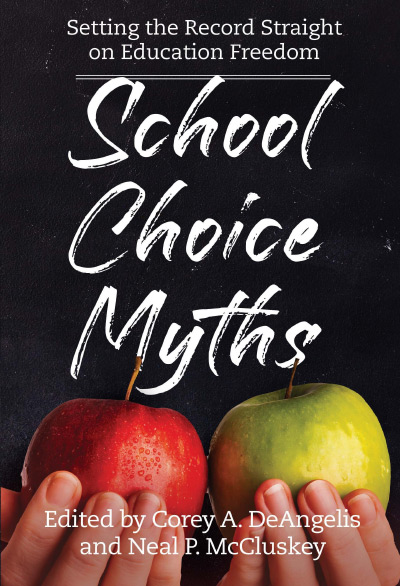 School Choice Myths: Setting the Record Straight on Education Freedom, ed. by Neal McCluskey and Corey A. DeAngelis. Cato Institute, 2020.
School Choice Myths: Setting the Record Straight on Education Freedom, ed. by Neal McCluskey and Corey A. DeAngelis. Cato Institute, 2020.
Publisher’s publicity material: “Are there legitimate arguments to prevent families from choosing the education that works best for their children? Opponents of school choice have certainly offered many objections, but for decades they have mainly repeated myths either because they did not know any better or perhaps to protect the government schooling monopoly.
“In these pages, 14 of the top scholars in education policy debunk a dozen of the most pernicious myths, including ‘school choice siphons money from public schools,’ ‘choice harms children left behind in public schools,’ ‘school choice has racist origins,’ and ‘choice only helps the rich get richer.’ As the contributors demonstrate, even arguments against school choice that seem to make powerful intuitive sense fall apart under scrutiny. There are, frankly, no compelling arguments against funding students directly instead of public school systems.” The contributors are Phillip W. Magness, Patrick J. Wolf, Tim Keller, Martin F. Lueken, Benjamin Scafidi, Matt Ladner, Albert A. Cheng, Lindsey M. Burke, Jason Bedrick, John Merrifield, Inez Feltscher Stepman, and Virginia Walden Ford.
School Choice: The Findings, by Herbert J. Walberg. Cato Institute, 2007.
This 135-page booklet was at the time of its publication the best concise introduction to the evidence on parental choice. It still stands up quite well. It summarizes the research on charter schools, opportunity scholarships (vouchers), private schools, voucher effects, and public opinion on parental choice. Terry M. Moe writes, “There has been considerable research on school choice over the last decade, producing a literature filled with controversy and conflicting findings. In this book, one of the nation’s most reputable education scholars provides a helpful overview and assessment of all this work—one that anyone interested in the choice issue can surely benefit from reading.”
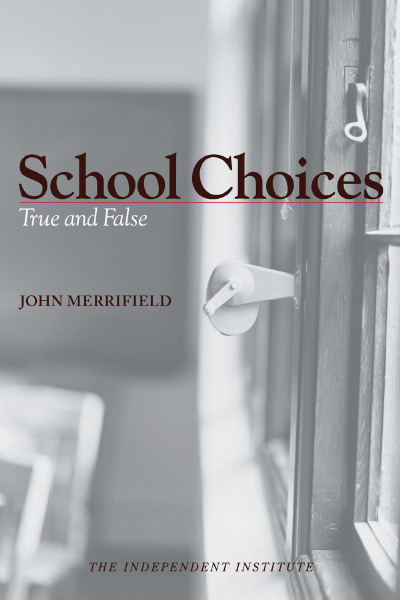 School Choices: True and False, by John D. Merrifield. Independent Institute, 2002.
School Choices: True and False, by John D. Merrifield. Independent Institute, 2002.
The Independent Institute’s synopsis reads, “Increasing numbers of students have found relief in private schools and homeschooling, but for most families, flight from the public schools is not a viable option. ... [School Choices] describes a school-reform proposal that would utilize market forces, especially genuine competition, to focus on the fate of children rather than the public school system, which is nothing more than a governing and funding process.”
Laurence Vance writes, “Although Merrifield harshly criticizes charter schools and tuition tax credits, his greatest attention and disdain are focused on voucher programs currently under way in Florida, Milwaukee, and Cleveland. However, this is not because they are voucher programs, but because they limit participation to low-income parents and low-performing schools (with the state grading its own schools), do not allow for add-ons (supplementing the tax-funded voucher to send a child to the higher-priced private schools), and are just plain too small to provide us with any meaningful results.”
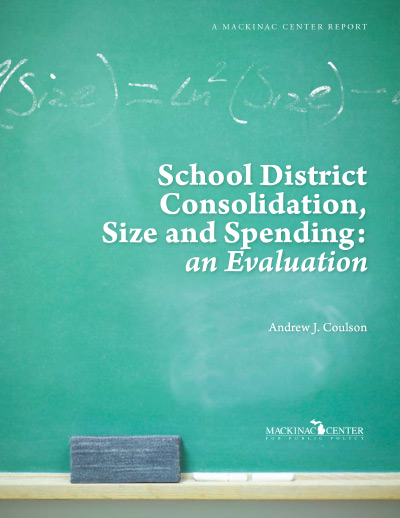 School District Consolidation, Size, and Spending, by Andrew J. Coulson. Mackinac Center for Public Policy, 2007. Download PDF
School District Consolidation, Size, and Spending, by Andrew J. Coulson. Mackinac Center for Public Policy, 2007. Download PDF
From the executive summary: “This study empirically tests the notion that consolidating smaller public school districts will save taxpayers money. ... [D]istrict size has a more nuanced and less important impact on spending that is often assumed, and the ... political emphasis on consolidation of small districts is misplaced. The author estimates that the potential savings from consolidating excessively small districts is about 12 times smaller than the potential savings from breaking up excessively large ones. ...
“[T]his study points to a far more important factor than district size: the incentive structure of the system itself. The model developed here indicates that public school districts generally endeavor to spend—and succeed in spending—as much as they can. ... [P]ublic schooling’s incentive structure appears to encourage district officials to maximize their budgets. To improve efficiency, ... this problematic incentive structure would have to be replaced with one in which school officials are instead rewarded for simultaneously controlling costs and maintaining or improving quality.”
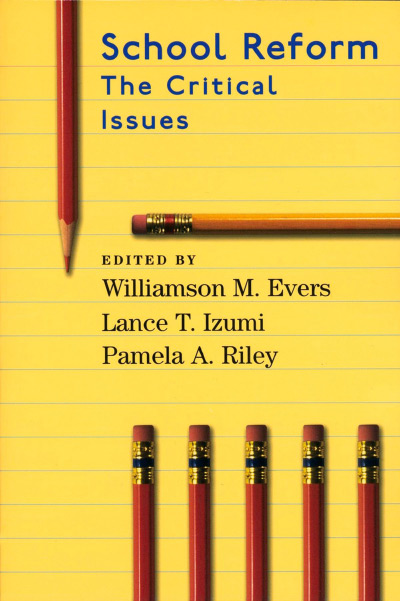 School Reform: The Critical Issues, ed. by Williamson M. Evers, Lance T. Izumi and Pamela A. Riley. Hoover Institution Press, 2001.
School Reform: The Critical Issues, ed. by Williamson M. Evers, Lance T. Izumi and Pamela A. Riley. Hoover Institution Press, 2001.
ERIC: “This book presents a collection of ... articles on the problems in today’s schools, why school and students are underperforming, exploring a range of topics and explaining why some reforms in education are destined to fail while others have been proven to work. The first section, ‘Teaching Approaches,’ presents articles on progressive education; curriculum and methods; computers/distance learning; direct instruction, explicit teaching; ability grouping; and whole-school reform. The second section, ‘The Student,’ offers articles on student beliefs/character education and social promotion. The third section, ‘Parents and Teachers,’ includes articles on such issues as the parent-school relationship, teacher salaries, teachers’ unions, and teacher evaluation. The fourth section, ‘Educationally Disadvantaged,’ discusses such issues as bilingual education, Ritalin, and special education. The fifth section, ‘Standards and Accountability,’ looks at the development of academic standards and the fight against testing. The sixth section, ‘Structuring Education,’ presents articles on spending, vouchers, contracting out, charter schools, class and school size, federal aid to education and the poor, home schooling, and private schooling.”
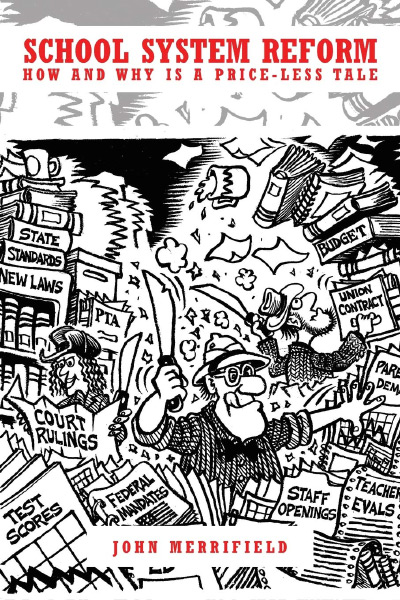 School System Reform: How and Why Is a Price-less Tale, by John Merrifield. Covenant Books, 2019.
School System Reform: How and Why Is a Price-less Tale, by John Merrifield. Covenant Books, 2019.
The argument of this book is that the potential for K-12 academic gains is vast if we would stop tinkering with the existing public school system and instead overthrow it and institute genuine competition. It contains many interesting insights, such as this one on competitive federalism: “All else equal, more rivalry among political jurisdictions through, for example, having more nearby school districts and greater student mobility, ... is better than having fewer school district offerings to choose from.
“But Tiebout competition is not nearly the same thing and has a much lower upside than genuine competition among business firms seeking profit and risking loss and bankruptcy. School districts do not compete for students in the same way that businesses compete for customers.”
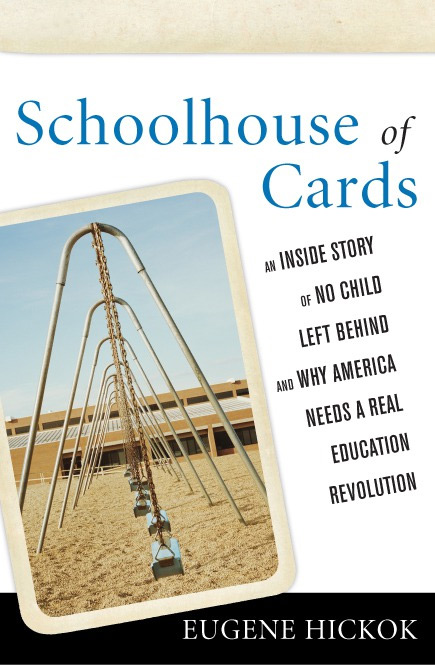 Schoolhouse of Cards: An Inside Story of No Child Left Behind and Why America Needs a Real Education Revolution, by Eugene W. Hickok. Rowman & Littlefield, 2010.
Schoolhouse of Cards: An Inside Story of No Child Left Behind and Why America Needs a Real Education Revolution, by Eugene W. Hickok. Rowman & Littlefield, 2010.
Rowman & Littlefield: “Eugene Hickok provides an insider’s account of [No Child Left Behind (NCLB)]. A former key player in the Department of Education during the [George W.] Bush administration, Hickok describes how Bush’s education agenda took shape during the campaign and his first year in office, how it achieved bipartisan support in Congress, and how it was implemented. Hickok believes that NCLB accomplished a few things but not enough and had flaws. In addition, he reveals that the tensions among individuals in the White House, on Capitol Hill, and within the Department of Education undermined the law’s implementation. In a final chapter Hickok criticizes reform efforts by Presidents [George W.] Bush and Obama as nipping at the margins, calling instead for a radical rethinking of public education in America.”
Frederick M. Hess writes: “Gene Hickok crafts a hard-hitting account of the politics and personalities behind the passage and implementation of No Child Left Behind. [He] offers a colorful behind-the-scenes account of how NCLB came about.” Hickok was Under Secretary of Education (2001-2004) and Deputy Secretary of Education (2004-2005) during the George W. Bush administration. Prior to that he was Secretary of Education for Pennsylvania and a professor of political science at Dickinson College.
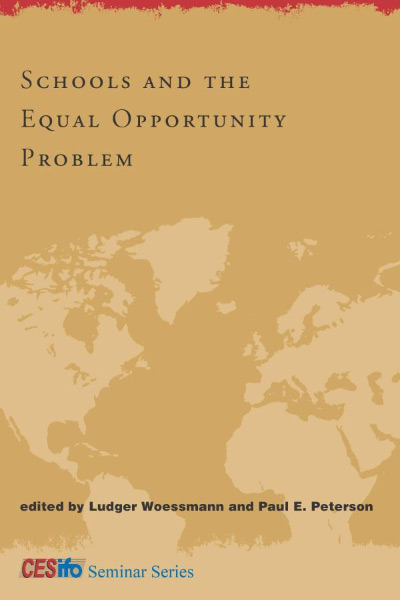 Schools and the Equal Opportunity Problem, by Ludger Wößmann and Paul E. Peterson. The MIT Press, 2007.
Schools and the Equal Opportunity Problem, by Ludger Wößmann and Paul E. Peterson. The MIT Press, 2007.
Much educational research today is focused on assessing reforms that are intended to create expanded opportunity for students. Many current policies aim at concentrating extra resources on children from low-income households. Research indicates, however, that even sizable differential spending on children from low-income households will not yield an equality of results.
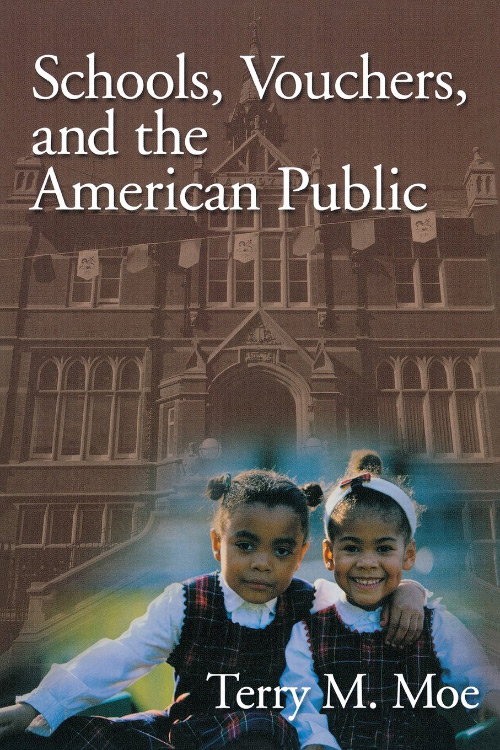 Schools, Vouchers, and the American Public, by Terry M. Moe. Brookings Institution Press, 2002.
Schools, Vouchers, and the American Public, by Terry M. Moe. Brookings Institution Press, 2002.
Richard D. Kahlenberg writes, “Moe’s ... book is not an argument for or against vouchers; it is an analysis of public opinion on vouchers that is likely to be very influential in shaping the movement’s future. Moe has written a nuanced and thoughtful treatise that goes beneath the notoriously unreliable single-shot question favored by the media: Do you favor or oppose school vouchers?” Paul E. Peterson writes, “In a brilliant, definitive analysis of the subject, Terry Moe tells us who does—and does not—like vouchers as well as who says they will use them, if the opportunity arises. He illuminates not only the school choice debate but the nature of public opinion more generally.”
“The Sheepskin Effect and Student Achievement: De-emphasizing the Role of Master’s Degrees in Teacher Compensation,” by Raegen Miller and Marguerite Roza, Center for American Progress, July 2012. Download PDF
Miller and Roza write, “Although teachers with master’s degrees generally earn additional salary or stipends—the so-called ‘master’s bump’—they are no more effective, on average, than their counterparts without master’s degrees.”
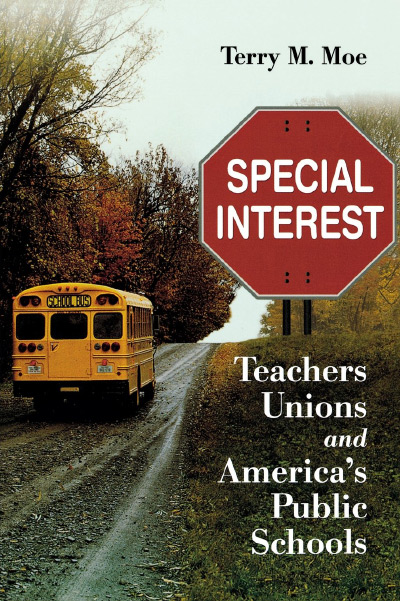 Special Interest: Teachers Unions and America’s Public Schools, by Terry M. Moe. Brookings Institution Press, 2011.
Special Interest: Teachers Unions and America’s Public Schools, by Terry M. Moe. Brookings Institution Press, 2011.
Joel Klein, former Chancellor of New York City Public Schools, writes, “America’s public schools are broken, and Terry Moe sets out to explain why. In a bare-knuckled and brilliant account, he shows how the teachers’ unions use their unmatched political power to control virtually every aspect of educational policy and practice. The result, not surprisingly, is a system that protects the interests of employees at the expense of our kids.”
Moe writes, “Interest-group influence is hardly unusual in American politics and government. Indeed, it is the normal state of affairs across all areas of public policy. To say that public education is an arena of special-interest influence, then, is simply to say that it is normal. If education is at all different, it is only because one special interest is far more powerful than any others. By focusing on that one special interest, then, and by learning about the various roles it plays in shaping the public schools and the policies that govern them, we should be able to learn a great deal about the American education system—and why its serious problems have yet to be overcome despite a quarter century of national effort.”
Martin R. West writes, “In painstaking detail, Moe documents myriads ways in which union power leads school districts to be ‘organized mainly to benefit the adults who work there.’ ... He shows how typical collective bargaining agreements make it all but impossible to dismiss incompetent teachers, impede efforts to assign teachers to jobs based on fit or performance rather than seniority, and contain detailed work rules that boost costs and stifle innovation. ... He also describes how unions use their political resources to block the adoption of reforms such as merit pay and expanded parental choice. ...”
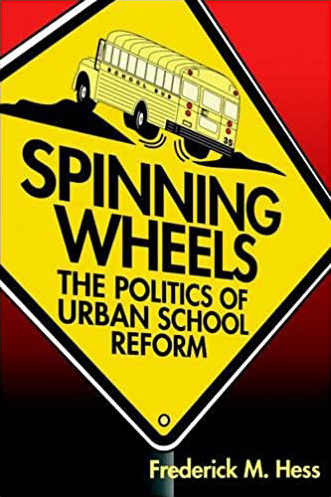 Spinning Wheels: The Politics of Urban School Reform, by Frederick M. Hess. Brookings Institution Press, 1998.
Spinning Wheels: The Politics of Urban School Reform, by Frederick M. Hess. Brookings Institution Press, 1998.
Publisher’s material: “Frederick Hess ... explains that political incentives drive school superintendents to promote reforms—to demonstrate that they are ‘making a difference.’ Superintendents have to do this quickly, both because their tenure is usually three years or less and because urban communities are anxious to see educational improvement. However, the nature of urban school districts makes it very difficult to demonstrate concrete short-term improvement. The result is what he terms ‘policy churn,’ which distracts teachers and principals from efforts to refine classroom teaching while seldom resulting in successful long-term changes.”
“The Structure of Educational Revolutions,” by Andy Smarick. National Affairs, Summer, 2017.
Andy Smarick writes, “Progressive Era reformers, seeking to rationalize America’s then-inchoate system of public education, decided that one government body — the school district — should own and operate all public schools in a particular geographic area. By consolidating power, this ‘exclusive-territory franchise’ model determined that future reforms would flow through a central apparatus and down to schools, not from the ground up. It also enabled ambitious reformers to scale their initiatives by moving to higher levels of government: Unsatisfied by district action, reformers worked through the state government, then moved up to the federal level. ... Common Core and Race to the Top can therefore be seen as the logical extension of earlier centralizing efforts. The organizational structure of American K-12 schooling imposed at the turn of the 20th century foreordained today’s educational technocracy.”
“Supporting Students Outside the Classroom,” by Michael Q. McShane. Education Next, vol. 19, no. 3 (Summer 2019): 38-45.
“Community schools” is a highly-touted effort in which schools provide “integrated student supports” or “wraparound services.” The schools “provide social services to [their] students either directly or by connecting them with existing programs.” Such welfare-state programs would include medical and dental care, mental health services, food aid, and shelter aid. The Swedish welfare state comes to school, if you will.
But does this approach deliver better academic results? McShane writes that “a close look at the research” on the effectiveness of community schools reveals that “their ability to improve student learning remains unproven.” McShane explains, “Large-scale evaluations” have found “only small benefits to student achievement, at best.”
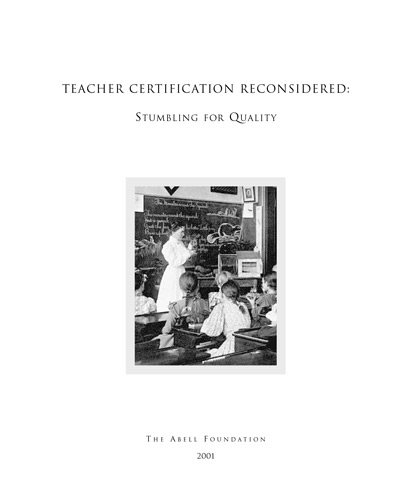 Teacher Certification Reconsidered: Stumbling for Quality, by Kate Walsh. Abell Foundation, 2001. [Download PDF]
Teacher Certification Reconsidered: Stumbling for Quality, by Kate Walsh. Abell Foundation, 2001. [Download PDF]
Walsh looks at the “claim by the education establishment that taking the coursework needed to obtain certification is not only the best, but also the only acceptable means for preparing teachers.” She describes “in detail the shortcomings found in [the research on the effects of teacher credentialing].” She contends that the academic research trying “to link teacher certification with student achievement” is “astonishingly deficient.” Walsh says teacher education research is “flawed, sloppy, aged, and sometimes academically dishonest.”
“Teacher Deselection,” by Eric A. Hanushek. In Creating a New Teaching Profession, ed. by Dan Goldhaber and Jane Hannaway, Urban Institute Press, 2009, pp. 165-180. Download PDF
From the author’s abstract: “[H]ow much progress in student achievement could be accomplished by instituting a program of removing, or deselecting, the least-effective teachers? A variety of policies for hiring and retraining teachers have been proposed, but they have not been very successful in the aggregate, as student performance has not improved. At the same time, it is widely recognized that some teachers do a very poor job, and few people believe that the worst teachers can be transformed into good teachers. What would happen if we simply adopted policies of systematically removing the most ineffective teachers?”
“Teacher Pension Plans Are Getting Riskier—and It Could Backfire on American Schools,” by Chad Aldeman. Brown Center Chalkboard Blog, Brookings Institution, February 25, 2020.
Alderman writes, “The faster [a teachers’ pension] plan assumes its investments will grow over time, the less it needs to save in the present to pay for its future promises. Yet, if a plan is overly optimistic, that decision could bring long-term consequences as the gap between assumptions and realities crystallizes. ... Even taking their own assumptions at face value, the typical teacher pension plan has not been fully funded at any point in the last two decades. Their overly aggressive investment assumptions have contributed to today’s unfunded liabilities, which collectively total over $500 billion.
“That figure takes for granted that all of their current assumptions are proven correct. But ...pension-plan investment assumptions are wildly out of touch with the markets. ... [T]he typical teacher pension plan today assumes it will earn 7.25% per year on its investments. Many economists argue those expectations are too high.”
“Teacher Performance Pay: A Survey,” by Michael J. Podgursky and Matthew G. Springer. Journal of Policy Analysis and Management, vol. 26, no. 4 (Autumn 2007): 909-950. Download PDF
Podgursky and Springer write, “Data from national surveys show that close to 100 percent of traditional public school teachers are employed in school districts that make use of salary schedules in pay-setting. Thus, roughly 3.1 million public school teachers from kindergarten through secondary level are paid largely on the basis of years of experience and education level—two variables weakly correlated, at best, with student outcomes. The single salary schedule tradition contrasts with pay determination practices in the majority of professions, where performance-related pay programs are commonplace.”
“Teachers Unions and American Education Reform: The Politics of Blocking,” by Terry M. Moe. The Forum, vol. 10, no. 1 (January 2012). Download PDF
Author’s abstract: “Why has the modern era of American education reform been such a disappointment? Why has a nation so dedicated to improving its schools continually pulled up short, year after year, embracing weak reforms unsuited to the challenge and refusing to throw off the shackles of the past? The answer comes down to simple fundamentals that have long been staples of political science: vested interests, checks and balances. The vested interests in this case are the teachers’ unions, which are by far the most powerful groups in the politics of education. And their power is magnified by the American system of checks and balances—which, quite by design, creates veto points that make it exceedingly difficult for reformers to get major new legislation passed and correspondingly easy for opponents to block. The teachers’ unions have been masters of the politics of blocking for the past quarter century. Major reform is threatening to their vested interests in the existing system, and they have used their formidable power—leveraged by checks and balances—to repel, weaken, and render ineffective the efforts of reformers to bring real change. This is the basic story of the modern reform era. The rest is detail.”
A more recent and updated variation on the same themes is published as a chapter in Moe’s book with Susanne Wiborg, The Comparative Politics of Education: Teachers Unions and Education Systems around the World (2017).
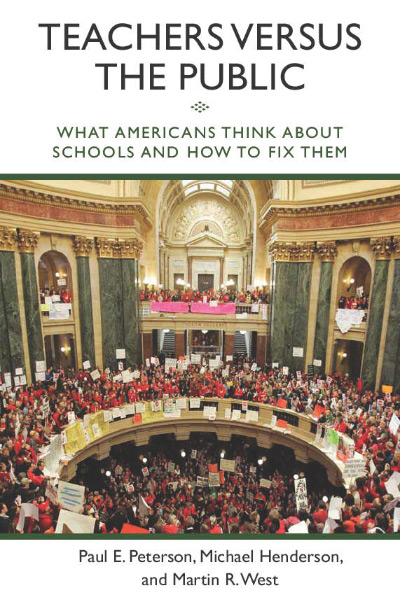 Teachers Versus The Public: What Americans Think About Schools and How to Fix Them, by Paul E. Peterson, Michael Henderson, and Martin R. West, Brookings institution Press, 2014.
Teachers Versus The Public: What Americans Think About Schools and How to Fix Them, by Paul E. Peterson, Michael Henderson, and Martin R. West, Brookings institution Press, 2014.
Eric A. Hanushek writes, “This scholarly book corrects and changes the political debate. The authors reveal that it is teachers themselves—not just their union representatives – who stand opposed to school reforms [that] a majority of the public favors.”
Testimony on the Proposed Department of Education before the Senate Committee on Education and Labor, and the House Committee on Education (February 25, 1926), by J. Gresham Machen. Congress of the United States.
Machen was a conservative Reformed theologian who taught at Princeton Theological Seminary. Machen said, “I do not believe that we ought to adopt this principle of standardization in education, which is writ so large in this bill; because standardization, it seems to me, destroys the personal character of human life. ...
“[T]he purpose of a great many educators when it comes to education today [is to make everyone just as much like everyone else as possible], and it is the purpose that underlies the tendency in this bill. It is to remove idiosyncrasies, to interfere with people who have peculiar ideas in education, and to try to produce a uniformity of education in this country.
“I do not believe that the personal, free, individual character of education can be preserved when you have a Federal department laying down standards of education which become more or less mandatory to the whole country.”
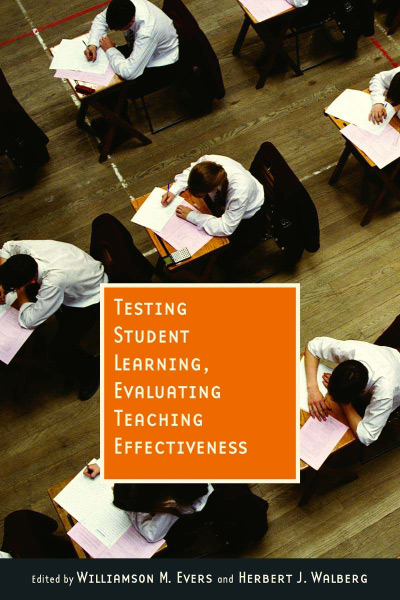 Testing Student Learning, Evaluating Teaching Effectiveness, ed. by Williamson M. Evers and Herbert J. Walberg. Hoover Institution Press, 2004.
Testing Student Learning, Evaluating Teaching Effectiveness, ed. by Williamson M. Evers and Herbert J. Walberg. Hoover Institution Press, 2004.
Hoover Institution Press: “Testing results can: (1) show educators’ and students’ strengths and weaknesses as a basis for planning; (2) inform educators and students of their progress or lack thereof; (3) reveal the degree to which educational products, programs, and practices are working and thus inform state and local boards about choices they face. In these and other ways described in the book, tests can play a vital role in improving American schools.”
The contributors are George K. Cunningham, University of Louisville; Jack M. Fletcher, University of Texas – Houston Health Science Center; Barbara R. Foorman, University of Texas – Houston Health Science Center; David J. Francis, University of Texas; Sandy Kress, Akin, Gump, Strauss, Hauer & Geld; William A. Mehrens, Michigan State University; Stan Metzenberg, California State University – Northridge; Richard P. Phelps, author and former educator; Alan R. Siegel, New York University; Brian Stecher, RAND; and Darvin M. Winick, University of Texas – Austin.
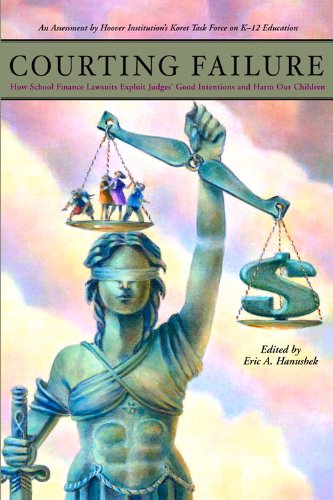 “Thorough and Efficient Private and Public Schools,” by Paul E. Peterson. In Courting Failure: How School Finance Lawsuits Exploit Judges’ Good Intentions and Harm our Children, ed. Eric A. Hanushek. Hoover Institution Press, 2006: 195-234. Download PDF
“Thorough and Efficient Private and Public Schools,” by Paul E. Peterson. In Courting Failure: How School Finance Lawsuits Exploit Judges’ Good Intentions and Harm our Children, ed. Eric A. Hanushek. Hoover Institution Press, 2006: 195-234. Download PDF
Peterson writes, “[I]t remains unclear whether increases in financial support, even substantial ones, can by themselves bring school performance up to the desired standard. In considering the connection between expenditure and school performance, much can be learned by examining the quality of schooling in the private sector. Private schools currently educate over 11 percent of students in the United States. They spend considerably less per pupil than public schools do. Yet the average performance of their students is as high or higher than that of students attending public schools. In this paper I identify various factors that could account for greater private school productivity, placing emphasis on the educational role played by ‘co-producers,’ that is, family, peers, and students themselves. In conclusion, I suggest that public schools, in order to become genuinely ‘thorough and efficient,’ need to attend to the lessons provided by private schools.”
“The Turnaround Fallacy,” by Andy Smarick. Education Next, vol. 10, no. 1 (Winter 2010): 20-26.
From the abstract on ERIC: “For as long as there have been struggling schools in America’s cities, there have been efforts to turn them around. But overall, school turnaround efforts have consistently fallen far short of hopes and expectations. Quite simply, turnarounds are not a scalable strategy for fixing America’s troubled urban school systems. ... When conscientiously applied strategies fail to drastically improve America’s lowest-performing schools, there is a need to close them. ... [T]his strategy will help the students assigned to these failing schools ...”
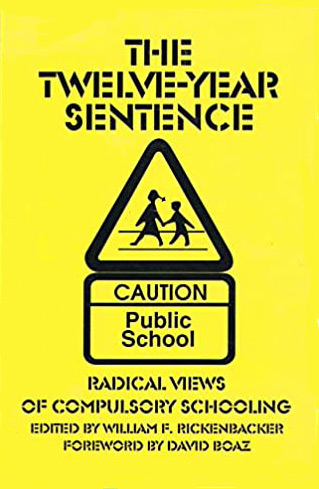 The Twelve-Year Sentence: Radical Views on Compulsory Education, ed. William Rickenbacker. Fox & Wilkes, 2014.
The Twelve-Year Sentence: Radical Views on Compulsory Education, ed. William Rickenbacker. Fox & Wilkes, 2014.
The contributors examine of how compulsory education reinforces complacency with the political status quo and government institutions.
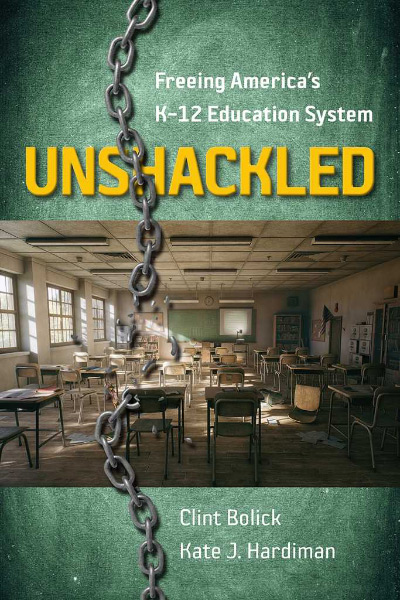 Unshackled: Freeing America’s K-12 Education System, by Clint Bolick and Kate J. Hardiman. Hoover Institution Press, 2021.
Unshackled: Freeing America’s K-12 Education System, by Clint Bolick and Kate J. Hardiman. Hoover Institution Press, 2021.
Clint Bolick says in an interview, “One of the major reforms that we propose is decentralizing and deregulating public schools so that each school is semi-autonomous. This would enable schools to hire and fire their own teachers. They would also be able to set differential pay rates and provide educational offerings that are geared toward their student population. ... If you add these reforms to the elimination or dramatic downsizing of school districts, we would free up substantial sums of money for classrooms. One of the statistics we point to in the book is that if the size of bureaucracy relative to the student population had remained the same over the last two decades, there would have been funds available to increase average teacher compensation by $12,000. Taken together, these reforms could restore teaching to the prized profession it should be. ...
“[T]he teachers’ unions and the school district bureaucracies have a very uneasy alliance on many issues, because they both benefit from more public spending. The fact of the matter is that so much of the funds are absorbed by the central bureaucracy that we think that we may be able to persuade teachers that their interests lie in more decentralization and deregulation.”
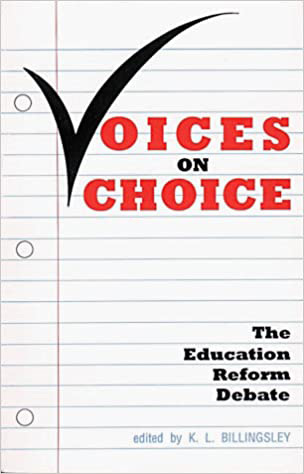 Voices on Choice: The Education Reform Debate, ed. K. Lloyd Billingsley. Pacific Research Institute, 1994.
Voices on Choice: The Education Reform Debate, ed. K. Lloyd Billingsley. Pacific Research Institute, 1994.
The short pieces in this slim book are readily accessible because they were first delivered as speeches. It provides balanced numbers of pro and con arguments on opportunity scholarships (vouchers).
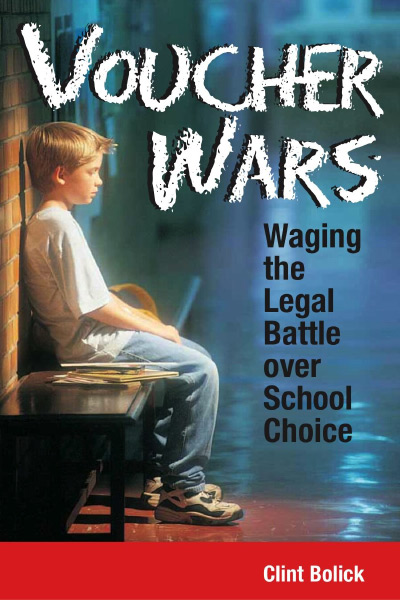 Voucher Wars: Waging the Legal Battle Over School Choice, by Clint Bolick. Cato Institute, 2003.
Voucher Wars: Waging the Legal Battle Over School Choice, by Clint Bolick. Cato Institute, 2003.
Milton Friedman writes, “Clint Bolick has written an exciting and fascinating account of his experience as a lawyer defending school choice. In the process, he provides a comprehensive history of the school choice movement from the 1990 enactment of the nation’s first urban school program in Wisconsin to the 2002 Supreme Court decision that established the constitutionality of voucher programs including religious schools. Clint makes clear how high the stakes are for the youngsters in low-income families condemned to failing government schools and how much their parents are willing to sacrifice to rescue them. A true human interest tale.”
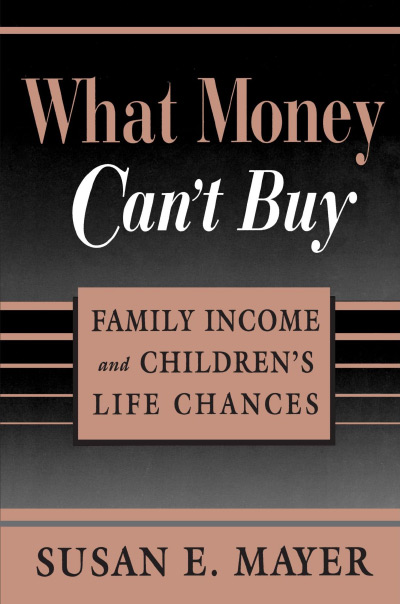 What Money Can’t Buy: Family Income and Children’s Life Chances, by Susan E. Mayer. Harvard University Press, 1998.
What Money Can’t Buy: Family Income and Children’s Life Chances, by Susan E. Mayer. Harvard University Press, 1998.
The Economist magazine writes, “[Susan Mayer] developed a statistical model that predicted what would happen to children’s prospects if poor families’ incomes were increased from $15,000 to $30,000 a year. The surprising answer is: not much. Ms Mayer found that although doubling the income of poor families would lift most children above the poverty line, it would have virtually no effect on their test scores and only a slight effect on social behaviour...There are two reasons for this. First, Ms Mayer notes that the extra money tends to be spent on such things as restaurant meals, clothes, dishwashers, roomier houses or second cars, none of which matters much in helping children succeed in school or life. ... Second, good parenting has much in common with being a good worker. In both roles, the reward goes to diligence, determination, good health, willingness to co-operate, and so on. Children with parents who possess these qualities tend to do well in life, even if mother and father do not make much money.”
Who Should Decide How Children Are Educated?, by Jack Klenk. Family Research Council, 2010. Download PDF
An accessible, but excellent discussion of parental rights in education. A philosophical and practical treatment of parental choice, including homeschooling.
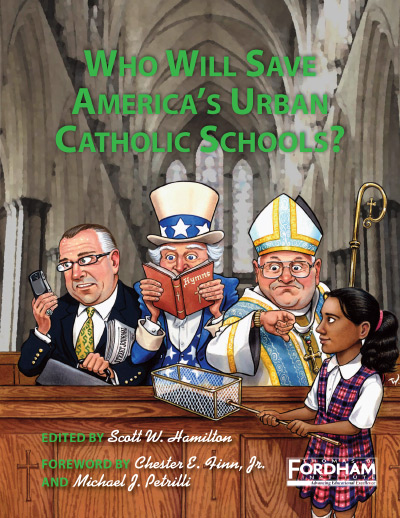 Who Will Save America’s Urban Catholic Schools?, ed. Scott Hamilton. Thomas B. Fordham Institute, 2008. Download PDF
Who Will Save America’s Urban Catholic Schools?, ed. Scott Hamilton. Thomas B. Fordham Institute, 2008. Download PDF
ERIC: “This report finds that over 1,300 schools have shut down since 1990, mostly in our cities. As a result, some 300,000 students have been displaced—forced to attend other public, private, or parochial schools. The school closures have cost taxpayers more than $20 billion to accommodate the additional students that public schools have had to absorb. Is this a crisis worth addressing? Are further closures inevitable, or can Church leaders, parishioners, philanthropists and/or public policymakers reverse these trends? Should they try? This report answers those questions and more. The report includes a comprehensive survey of the attitudes of U.S. Catholics and the broader public toward inner-city Catholic schools, examines this crisis and offers several suggestions for arresting and perhaps reversing this trend in the interests of better education. By looking at seven case studies, the report shows that in a few cities, such as Wichita, urban Catholic education is making a comeback.”
Why Charter Schools: The Princeton Story, by Chiarra R. Nappi. Thomas B. Fordham Institute, 1999. Download PDF
Nappi (a theoretical physicist at the Institute for Advanced Study) tells how Princeton, N.J. public-school parents endeavored to raise academic expectations by trying to change “the system” from within but had to resort to starting a charter school. Chester E. Finn Jr. writes, “‘Why Charter Schools? The Princeton Story’ reveals that the need for choice and competition is not restricted to families in inner cities. When parents in Princeton, New Jersey, one of America’s most privileged communities, became frustrated by the absence of clear standards of learning in their public schools, they first approached teachers and principals. When they got no satisfaction, and the education status quo remained, some of them ran for seats on the school board.
“Some of the reform-minded parents won, but their victory turned out to be hollow, as the real power over key education decisions continued to be wielded by the teachers’ union, which was able to resist curricular reform by insisting that such decisions properly belonged in the hands of professionals. The story told in this report shows how difficult it is for education-minded parents in a community to reform their public schools.”
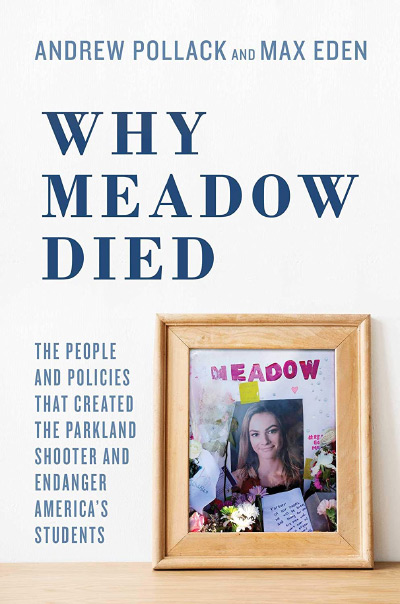 Why Meadow Died: The People and Policies That Created The Parkland Shooter and Endanger America’s Students, by Andrew Pollack and Max Eden. Post Hill Press, 2019.
Why Meadow Died: The People and Policies That Created The Parkland Shooter and Endanger America’s Students, by Andrew Pollack and Max Eden. Post Hill Press, 2019.
Pollack, a parent whose daughter was shot in the 2018 Stoneman Douglas High School attack in Florida and education-policy analyst Eden blame not only the shooter, but also the Broward County school district’s “restorative justice” program and what they call a “culture of pathological unaccountability.” Behavior “doesn’t magically get better,” Pollack and Eden point out, when you decide to “not punish mischief.” What happens is that matters “get worse for students and teachers” but “look better on paper for bureaucrats and activists.” Broward’s disciplinary practices had been, in Frederick Hess’s words, "hailed as a national model" by many in public education.
“Why We Fight: How Public Schools Cause Social Conflict,” by Neal McCluskey. Cato Institute Policy Analysis, no. 587, January 23, 2007. Download PDF
McCluskey writes, “Public schooling—in which diverse people are required to pay for a single system of government‐run schools—inherently sets up ... conflicts. When two things cannot be simultaneously taught as true, or different values dictate different policies, one side must win, and the other lose. ... [S]uch conflicts ... are not particularly rare. [To assume that] public schooling will create harmony is dangerous, even if it is widely accepted. Indeed, it makes little logical sense.”
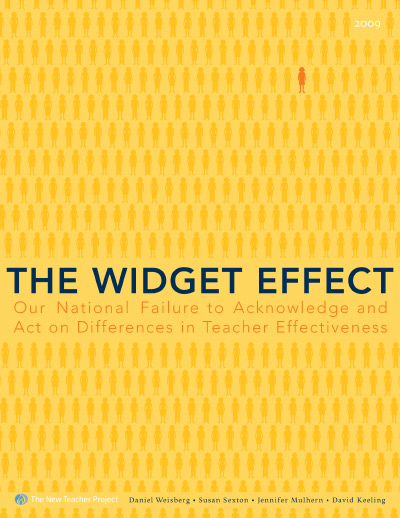 The Widget Effect: Our National Failure to Acknowledge and Act on Differences in Teacher Effectiveness, by Daniel Weisberg, Susan Sexton, Jennifer Mulhern, and David Keeling. New Teacher Project, 2009. Download PDF
The Widget Effect: Our National Failure to Acknowledge and Act on Differences in Teacher Effectiveness, by Daniel Weisberg, Susan Sexton, Jennifer Mulhern, and David Keeling. New Teacher Project, 2009. Download PDF
From the executive summary: “Suppose you are a parent determined to make sure your child gets the best possible education. You understand intuitively what an ample body of research proves: that your child’s education depends to a large extent on the quality of her teachers. ...
“[Y]ou would be dismayed to discover that not only can no one tell you which teachers are most effective, they also cannot say which are the least effective or which fall in between. Were you to examine the district’s teacher evaluation records yourself, you would find that, on paper, almost every teacher is a great teacher, even at schools where the chance of a student succeeding academically amounts to a coin toss, at best. In short, the school district would ask you to trust that it can provide your child a quality education, even though it cannot honestly tell you whether it is providing her a quality teacher. This is the reality for our public school districts nationwide. Put simply, they fail to distinguish great teaching from good, good from fair, and fair from poor. A teacher’s effectiveness—the most important factor for schools in improving student achievement—is not measured, recorded, or used to inform decision making in any meaningful way.”

